Impact of Social Media on Young People's Health: A Case of Public Health England, UK
VerifiedAdded on 2023/06/14
|23
|4885
|86
AI Summary
This research aims to analyze the impact of social media on young people's health in case of Public Health England, UK. The research methodology includes interpretivism research philosophy, inductive research approach, mixed research design, survey through questionnaire technique, and probability sampling technique. The research plan includes choosing a feasible research topic, building aim and objectives, pooling the facts and figures through data gathering method, designing of the survey through questionnaire, choosing a sample from the targeted population, analysis of data and interpretation, final drafting and report writing, and project submission.
Contribute Materials
Your contribution can guide someone’s learning journey. Share your
documents today.
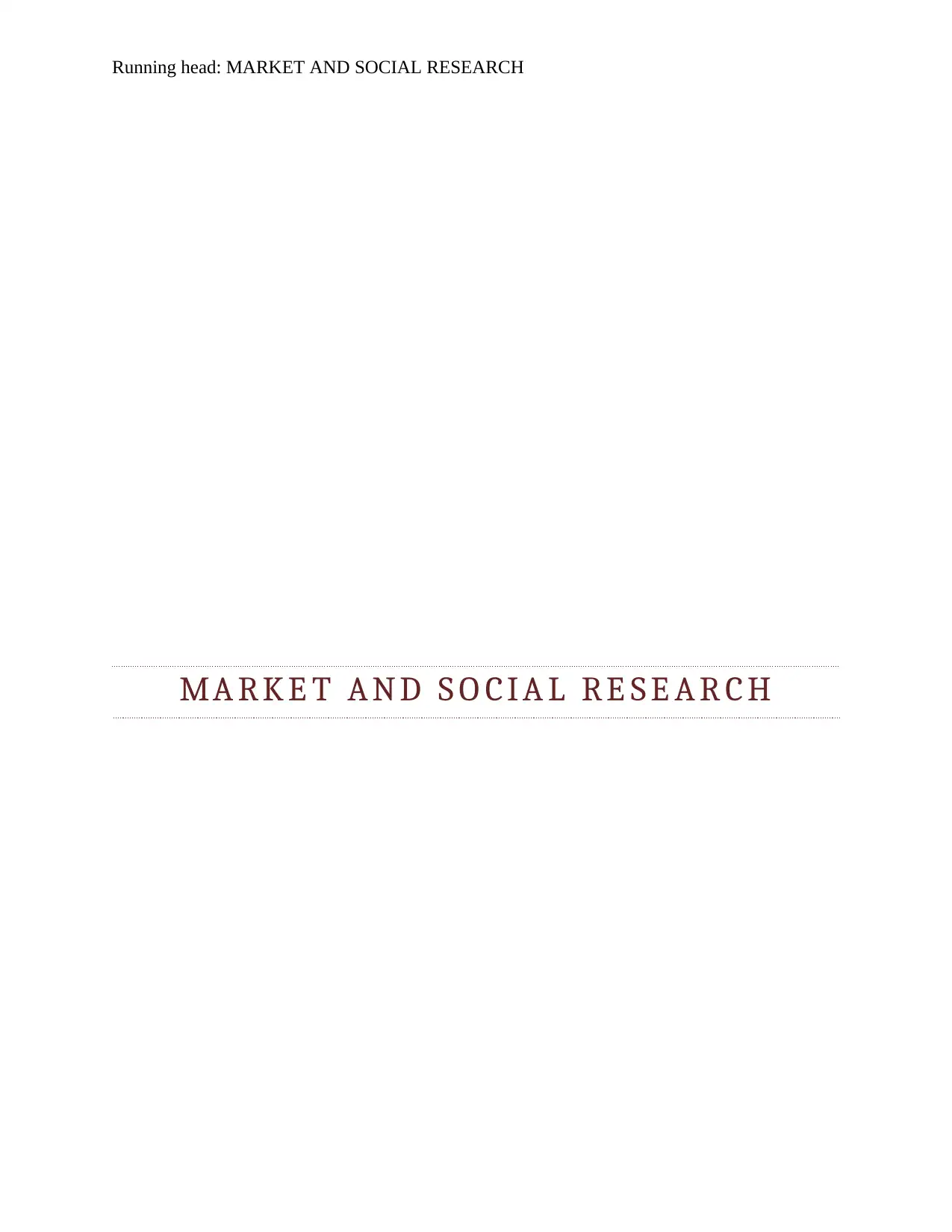
Running head: MARKET AND SOCIAL RESEARCH
M A R K E T A N D S O C I A L R E S E A R C H
M A R K E T A N D S O C I A L R E S E A R C H
Secure Best Marks with AI Grader
Need help grading? Try our AI Grader for instant feedback on your assignments.

MARKET AND SOCIAL RESEARCH 2
Table of Contents
Topic: to analyze the impact of social media on young people’s health: a case of Public Health
England, UK............................................................................................................................................................................... 3
Background:.............................................................................................................................................................................. 3
Research methodology and methods:............................................................................................................................. 4
Research plan........................................................................................................................................................................... 9
Design the data collection instrument:........................................................................................................................ 11
Appendix A: Survey through questionnaire.......................................................................................................... 11
Appendix B: Changes made from Pilot to final questionnaire.......................................................................13
Appendix C: Justification of question in regards to research objectives...................................................14
Bibliography........................................................................................................................................................................... 16
Table of Contents
Topic: to analyze the impact of social media on young people’s health: a case of Public Health
England, UK............................................................................................................................................................................... 3
Background:.............................................................................................................................................................................. 3
Research methodology and methods:............................................................................................................................. 4
Research plan........................................................................................................................................................................... 9
Design the data collection instrument:........................................................................................................................ 11
Appendix A: Survey through questionnaire.......................................................................................................... 11
Appendix B: Changes made from Pilot to final questionnaire.......................................................................13
Appendix C: Justification of question in regards to research objectives...................................................14
Bibliography........................................................................................................................................................................... 16
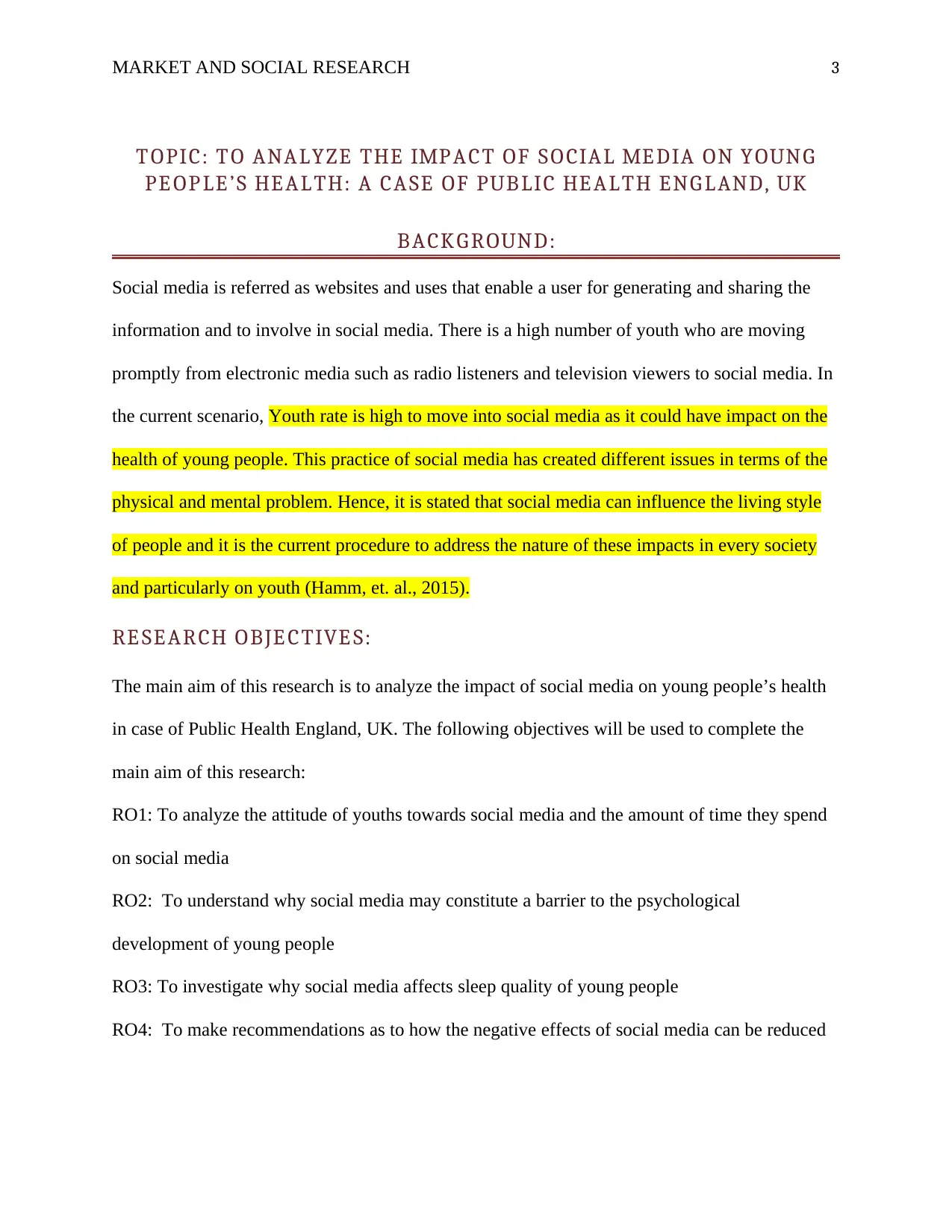
MARKET AND SOCIAL RESEARCH 3
TOPIC: TO ANALYZE THE IMPACT OF SOCIAL MEDIA ON YOUNG
PEOPLE’S HEALTH: A CASE OF PUBLIC HEALTH ENGLAND, UK
BACKGROUND:
Social media is referred as websites and uses that enable a user for generating and sharing the
information and to involve in social media. There is a high number of youth who are moving
promptly from electronic media such as radio listeners and television viewers to social media. In
the current scenario, Youth rate is high to move into social media as it could have impact on the
health of young people. This practice of social media has created different issues in terms of the
physical and mental problem. Hence, it is stated that social media can influence the living style
of people and it is the current procedure to address the nature of these impacts in every society
and particularly on youth (Hamm, et. al., 2015).
RESEARCH OBJECTIVES:
The main aim of this research is to analyze the impact of social media on young people’s health
in case of Public Health England, UK. The following objectives will be used to complete the
main aim of this research:
RO1: To analyze the attitude of youths towards social media and the amount of time they spend
on social media
RO2: To understand why social media may constitute a barrier to the psychological
development of young people
RO3: To investigate why social media affects sleep quality of young people
RO4: To make recommendations as to how the negative effects of social media can be reduced
TOPIC: TO ANALYZE THE IMPACT OF SOCIAL MEDIA ON YOUNG
PEOPLE’S HEALTH: A CASE OF PUBLIC HEALTH ENGLAND, UK
BACKGROUND:
Social media is referred as websites and uses that enable a user for generating and sharing the
information and to involve in social media. There is a high number of youth who are moving
promptly from electronic media such as radio listeners and television viewers to social media. In
the current scenario, Youth rate is high to move into social media as it could have impact on the
health of young people. This practice of social media has created different issues in terms of the
physical and mental problem. Hence, it is stated that social media can influence the living style
of people and it is the current procedure to address the nature of these impacts in every society
and particularly on youth (Hamm, et. al., 2015).
RESEARCH OBJECTIVES:
The main aim of this research is to analyze the impact of social media on young people’s health
in case of Public Health England, UK. The following objectives will be used to complete the
main aim of this research:
RO1: To analyze the attitude of youths towards social media and the amount of time they spend
on social media
RO2: To understand why social media may constitute a barrier to the psychological
development of young people
RO3: To investigate why social media affects sleep quality of young people
RO4: To make recommendations as to how the negative effects of social media can be reduced
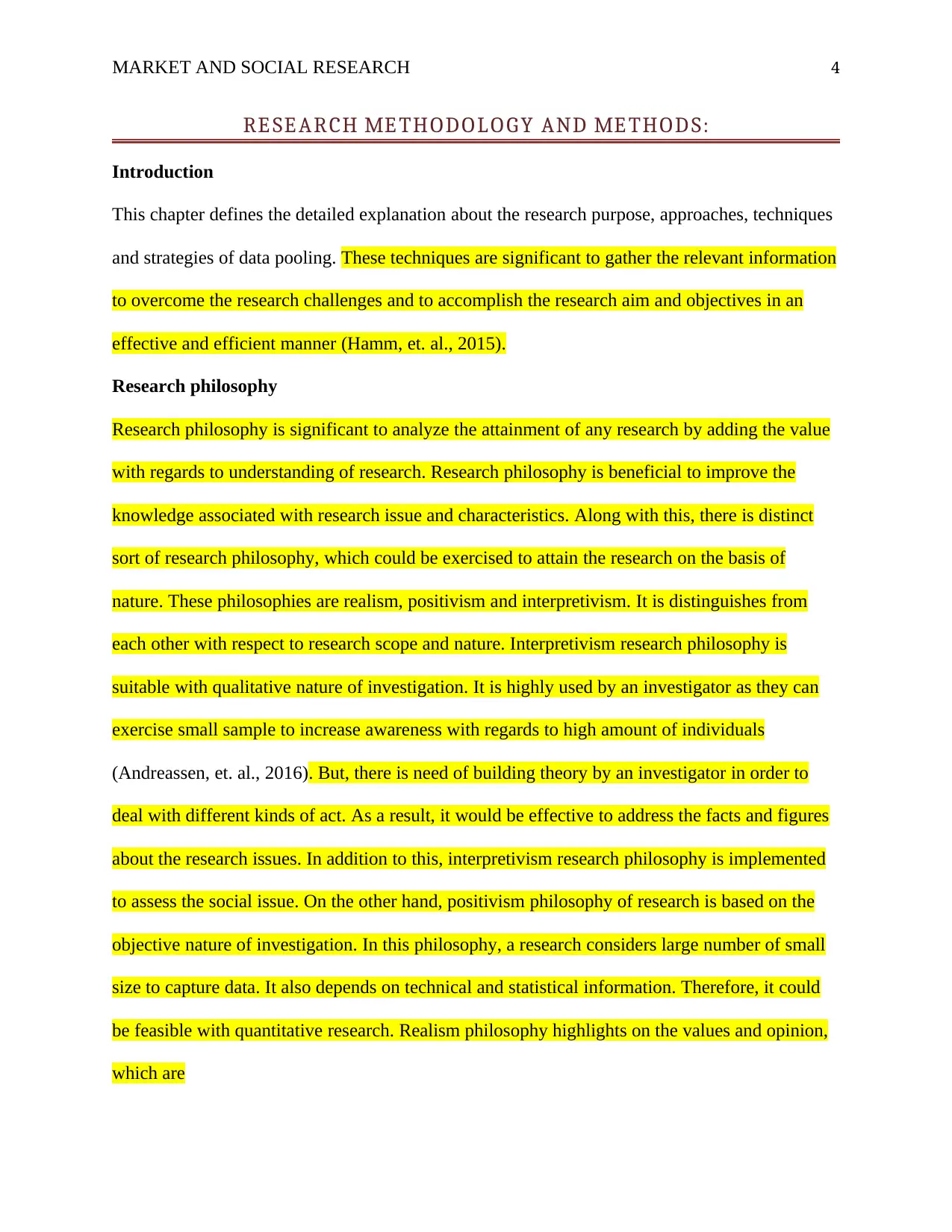
MARKET AND SOCIAL RESEARCH 4
RESEARCH METHODOLOGY AND METHODS:
Introduction
This chapter defines the detailed explanation about the research purpose, approaches, techniques
and strategies of data pooling. These techniques are significant to gather the relevant information
to overcome the research challenges and to accomplish the research aim and objectives in an
effective and efficient manner (Hamm, et. al., 2015).
Research philosophy
Research philosophy is significant to analyze the attainment of any research by adding the value
with regards to understanding of research. Research philosophy is beneficial to improve the
knowledge associated with research issue and characteristics. Along with this, there is distinct
sort of research philosophy, which could be exercised to attain the research on the basis of
nature. These philosophies are realism, positivism and interpretivism. It is distinguishes from
each other with respect to research scope and nature. Interpretivism research philosophy is
suitable with qualitative nature of investigation. It is highly used by an investigator as they can
exercise small sample to increase awareness with regards to high amount of individuals
(Andreassen, et. al., 2016). But, there is need of building theory by an investigator in order to
deal with different kinds of act. As a result, it would be effective to address the facts and figures
about the research issues. In addition to this, interpretivism research philosophy is implemented
to assess the social issue. On the other hand, positivism philosophy of research is based on the
objective nature of investigation. In this philosophy, a research considers large number of small
size to capture data. It also depends on technical and statistical information. Therefore, it could
be feasible with quantitative research. Realism philosophy highlights on the values and opinion,
which are
RESEARCH METHODOLOGY AND METHODS:
Introduction
This chapter defines the detailed explanation about the research purpose, approaches, techniques
and strategies of data pooling. These techniques are significant to gather the relevant information
to overcome the research challenges and to accomplish the research aim and objectives in an
effective and efficient manner (Hamm, et. al., 2015).
Research philosophy
Research philosophy is significant to analyze the attainment of any research by adding the value
with regards to understanding of research. Research philosophy is beneficial to improve the
knowledge associated with research issue and characteristics. Along with this, there is distinct
sort of research philosophy, which could be exercised to attain the research on the basis of
nature. These philosophies are realism, positivism and interpretivism. It is distinguishes from
each other with respect to research scope and nature. Interpretivism research philosophy is
suitable with qualitative nature of investigation. It is highly used by an investigator as they can
exercise small sample to increase awareness with regards to high amount of individuals
(Andreassen, et. al., 2016). But, there is need of building theory by an investigator in order to
deal with different kinds of act. As a result, it would be effective to address the facts and figures
about the research issues. In addition to this, interpretivism research philosophy is implemented
to assess the social issue. On the other hand, positivism philosophy of research is based on the
objective nature of investigation. In this philosophy, a research considers large number of small
size to capture data. It also depends on technical and statistical information. Therefore, it could
be feasible with quantitative research. Realism philosophy highlights on the values and opinion,
which are
Secure Best Marks with AI Grader
Need help grading? Try our AI Grader for instant feedback on your assignments.
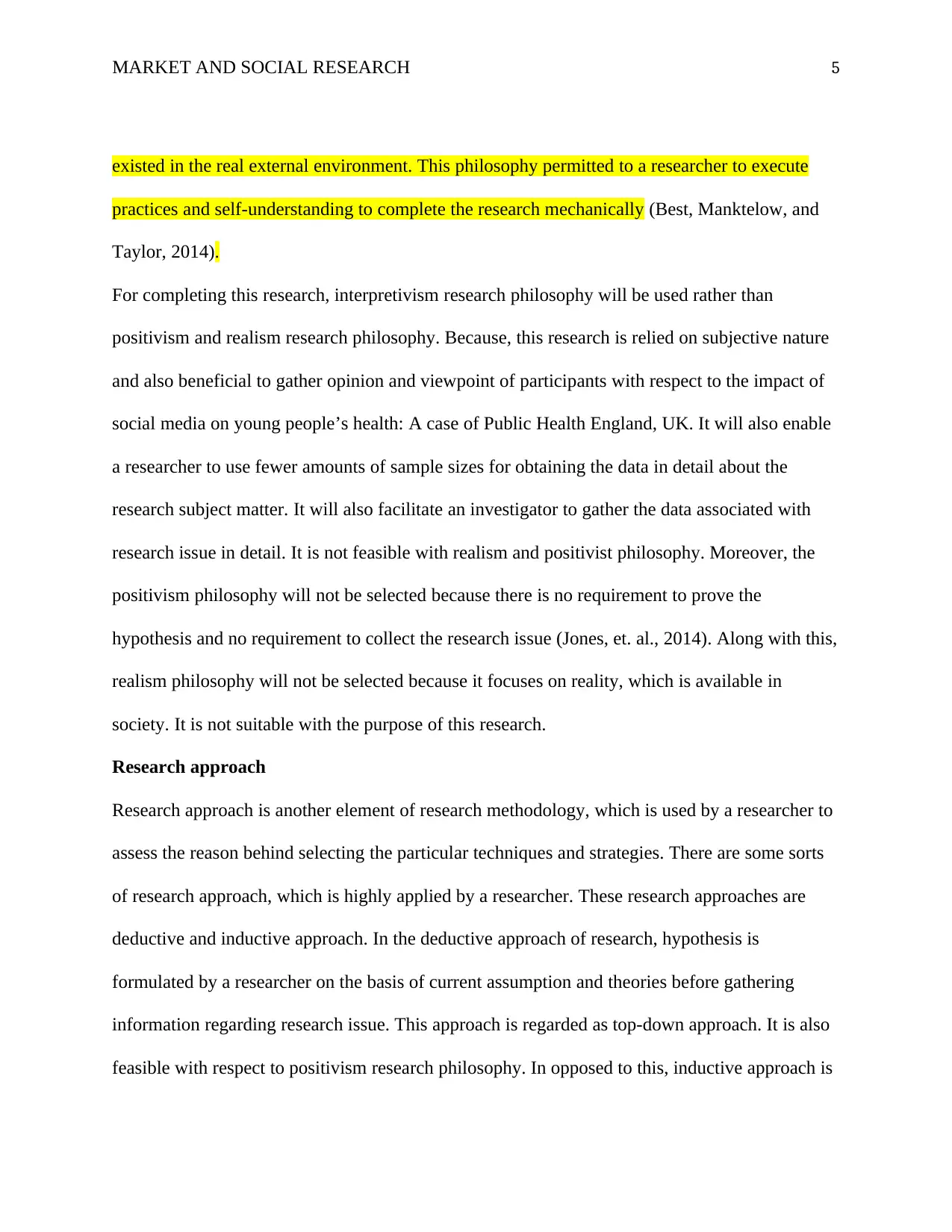
MARKET AND SOCIAL RESEARCH 5
existed in the real external environment. This philosophy permitted to a researcher to execute
practices and self-understanding to complete the research mechanically (Best, Manktelow, and
Taylor, 2014).
For completing this research, interpretivism research philosophy will be used rather than
positivism and realism research philosophy. Because, this research is relied on subjective nature
and also beneficial to gather opinion and viewpoint of participants with respect to the impact of
social media on young people’s health: A case of Public Health England, UK. It will also enable
a researcher to use fewer amounts of sample sizes for obtaining the data in detail about the
research subject matter. It will also facilitate an investigator to gather the data associated with
research issue in detail. It is not feasible with realism and positivist philosophy. Moreover, the
positivism philosophy will not be selected because there is no requirement to prove the
hypothesis and no requirement to collect the research issue (Jones, et. al., 2014). Along with this,
realism philosophy will not be selected because it focuses on reality, which is available in
society. It is not suitable with the purpose of this research.
Research approach
Research approach is another element of research methodology, which is used by a researcher to
assess the reason behind selecting the particular techniques and strategies. There are some sorts
of research approach, which is highly applied by a researcher. These research approaches are
deductive and inductive approach. In the deductive approach of research, hypothesis is
formulated by a researcher on the basis of current assumption and theories before gathering
information regarding research issue. This approach is regarded as top-down approach. It is also
feasible with respect to positivism research philosophy. In opposed to this, inductive approach is
existed in the real external environment. This philosophy permitted to a researcher to execute
practices and self-understanding to complete the research mechanically (Best, Manktelow, and
Taylor, 2014).
For completing this research, interpretivism research philosophy will be used rather than
positivism and realism research philosophy. Because, this research is relied on subjective nature
and also beneficial to gather opinion and viewpoint of participants with respect to the impact of
social media on young people’s health: A case of Public Health England, UK. It will also enable
a researcher to use fewer amounts of sample sizes for obtaining the data in detail about the
research subject matter. It will also facilitate an investigator to gather the data associated with
research issue in detail. It is not feasible with realism and positivist philosophy. Moreover, the
positivism philosophy will not be selected because there is no requirement to prove the
hypothesis and no requirement to collect the research issue (Jones, et. al., 2014). Along with this,
realism philosophy will not be selected because it focuses on reality, which is available in
society. It is not suitable with the purpose of this research.
Research approach
Research approach is another element of research methodology, which is used by a researcher to
assess the reason behind selecting the particular techniques and strategies. There are some sorts
of research approach, which is highly applied by a researcher. These research approaches are
deductive and inductive approach. In the deductive approach of research, hypothesis is
formulated by a researcher on the basis of current assumption and theories before gathering
information regarding research issue. This approach is regarded as top-down approach. It is also
feasible with respect to positivism research philosophy. In opposed to this, inductive approach is
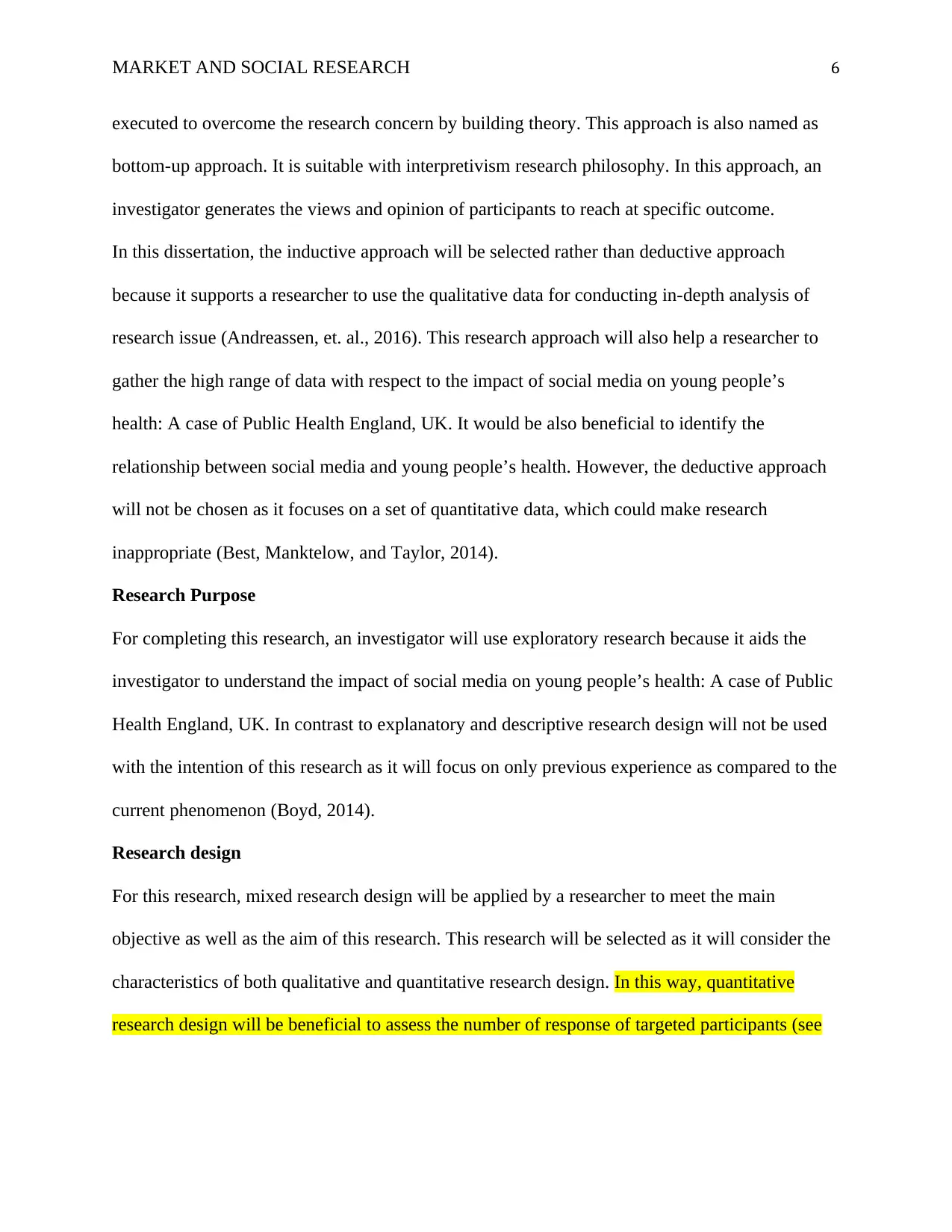
MARKET AND SOCIAL RESEARCH 6
executed to overcome the research concern by building theory. This approach is also named as
bottom-up approach. It is suitable with interpretivism research philosophy. In this approach, an
investigator generates the views and opinion of participants to reach at specific outcome.
In this dissertation, the inductive approach will be selected rather than deductive approach
because it supports a researcher to use the qualitative data for conducting in-depth analysis of
research issue (Andreassen, et. al., 2016). This research approach will also help a researcher to
gather the high range of data with respect to the impact of social media on young people’s
health: A case of Public Health England, UK. It would be also beneficial to identify the
relationship between social media and young people’s health. However, the deductive approach
will not be chosen as it focuses on a set of quantitative data, which could make research
inappropriate (Best, Manktelow, and Taylor, 2014).
Research Purpose
For completing this research, an investigator will use exploratory research because it aids the
investigator to understand the impact of social media on young people’s health: A case of Public
Health England, UK. In contrast to explanatory and descriptive research design will not be used
with the intention of this research as it will focus on only previous experience as compared to the
current phenomenon (Boyd, 2014).
Research design
For this research, mixed research design will be applied by a researcher to meet the main
objective as well as the aim of this research. This research will be selected as it will consider the
characteristics of both qualitative and quantitative research design. In this way, quantitative
research design will be beneficial to assess the number of response of targeted participants (see
executed to overcome the research concern by building theory. This approach is also named as
bottom-up approach. It is suitable with interpretivism research philosophy. In this approach, an
investigator generates the views and opinion of participants to reach at specific outcome.
In this dissertation, the inductive approach will be selected rather than deductive approach
because it supports a researcher to use the qualitative data for conducting in-depth analysis of
research issue (Andreassen, et. al., 2016). This research approach will also help a researcher to
gather the high range of data with respect to the impact of social media on young people’s
health: A case of Public Health England, UK. It would be also beneficial to identify the
relationship between social media and young people’s health. However, the deductive approach
will not be chosen as it focuses on a set of quantitative data, which could make research
inappropriate (Best, Manktelow, and Taylor, 2014).
Research Purpose
For completing this research, an investigator will use exploratory research because it aids the
investigator to understand the impact of social media on young people’s health: A case of Public
Health England, UK. In contrast to explanatory and descriptive research design will not be used
with the intention of this research as it will focus on only previous experience as compared to the
current phenomenon (Boyd, 2014).
Research design
For this research, mixed research design will be applied by a researcher to meet the main
objective as well as the aim of this research. This research will be selected as it will consider the
characteristics of both qualitative and quantitative research design. In this way, quantitative
research design will be beneficial to assess the number of response of targeted participants (see
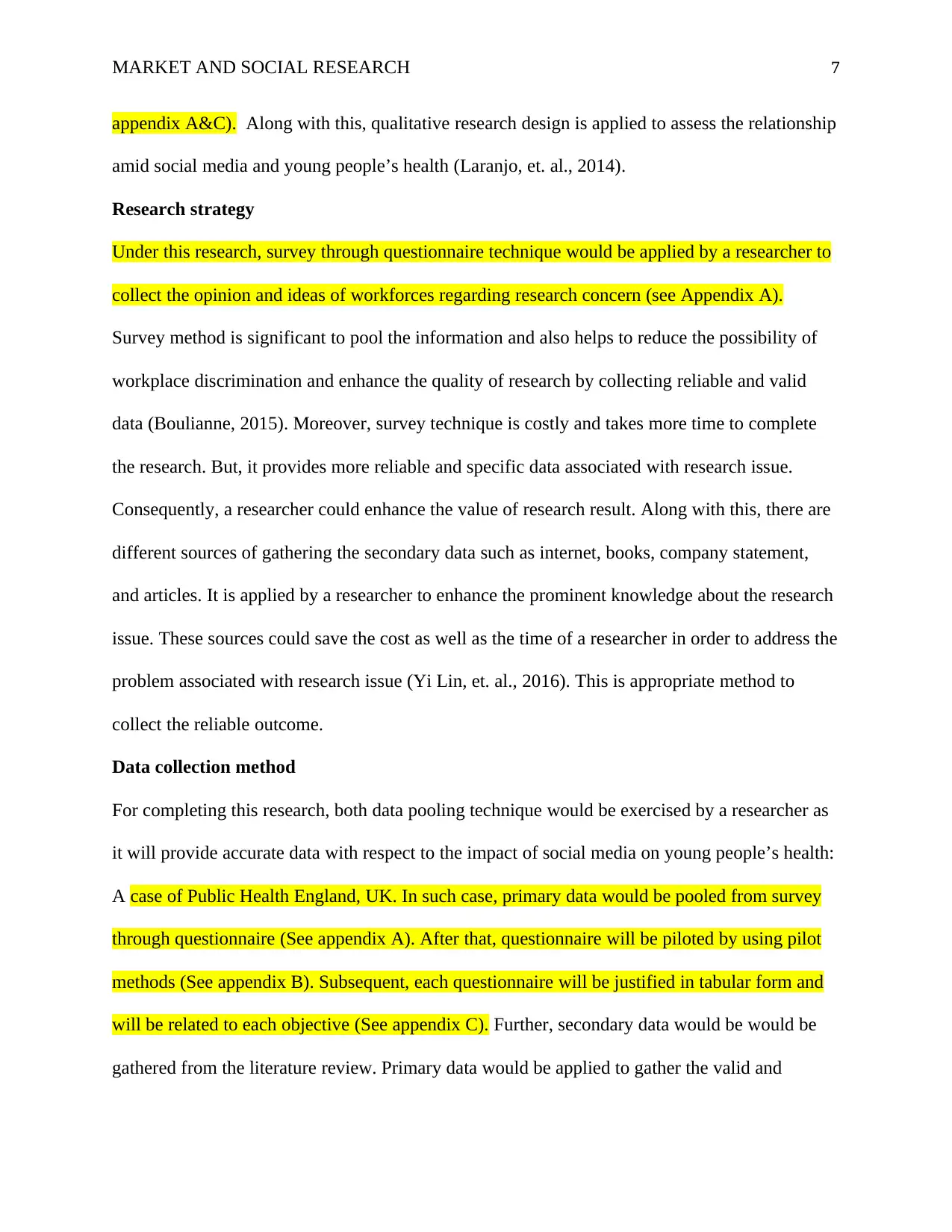
MARKET AND SOCIAL RESEARCH 7
appendix A&C). Along with this, qualitative research design is applied to assess the relationship
amid social media and young people’s health (Laranjo, et. al., 2014).
Research strategy
Under this research, survey through questionnaire technique would be applied by a researcher to
collect the opinion and ideas of workforces regarding research concern (see Appendix A).
Survey method is significant to pool the information and also helps to reduce the possibility of
workplace discrimination and enhance the quality of research by collecting reliable and valid
data (Boulianne, 2015). Moreover, survey technique is costly and takes more time to complete
the research. But, it provides more reliable and specific data associated with research issue.
Consequently, a researcher could enhance the value of research result. Along with this, there are
different sources of gathering the secondary data such as internet, books, company statement,
and articles. It is applied by a researcher to enhance the prominent knowledge about the research
issue. These sources could save the cost as well as the time of a researcher in order to address the
problem associated with research issue (Yi Lin, et. al., 2016). This is appropriate method to
collect the reliable outcome.
Data collection method
For completing this research, both data pooling technique would be exercised by a researcher as
it will provide accurate data with respect to the impact of social media on young people’s health:
A case of Public Health England, UK. In such case, primary data would be pooled from survey
through questionnaire (See appendix A). After that, questionnaire will be piloted by using pilot
methods (See appendix B). Subsequent, each questionnaire will be justified in tabular form and
will be related to each objective (See appendix C). Further, secondary data would be would be
gathered from the literature review. Primary data would be applied to gather the valid and
appendix A&C). Along with this, qualitative research design is applied to assess the relationship
amid social media and young people’s health (Laranjo, et. al., 2014).
Research strategy
Under this research, survey through questionnaire technique would be applied by a researcher to
collect the opinion and ideas of workforces regarding research concern (see Appendix A).
Survey method is significant to pool the information and also helps to reduce the possibility of
workplace discrimination and enhance the quality of research by collecting reliable and valid
data (Boulianne, 2015). Moreover, survey technique is costly and takes more time to complete
the research. But, it provides more reliable and specific data associated with research issue.
Consequently, a researcher could enhance the value of research result. Along with this, there are
different sources of gathering the secondary data such as internet, books, company statement,
and articles. It is applied by a researcher to enhance the prominent knowledge about the research
issue. These sources could save the cost as well as the time of a researcher in order to address the
problem associated with research issue (Yi Lin, et. al., 2016). This is appropriate method to
collect the reliable outcome.
Data collection method
For completing this research, both data pooling technique would be exercised by a researcher as
it will provide accurate data with respect to the impact of social media on young people’s health:
A case of Public Health England, UK. In such case, primary data would be pooled from survey
through questionnaire (See appendix A). After that, questionnaire will be piloted by using pilot
methods (See appendix B). Subsequent, each questionnaire will be justified in tabular form and
will be related to each objective (See appendix C). Further, secondary data would be would be
gathered from the literature review. Primary data would be applied to gather the valid and
Paraphrase This Document
Need a fresh take? Get an instant paraphrase of this document with our AI Paraphraser
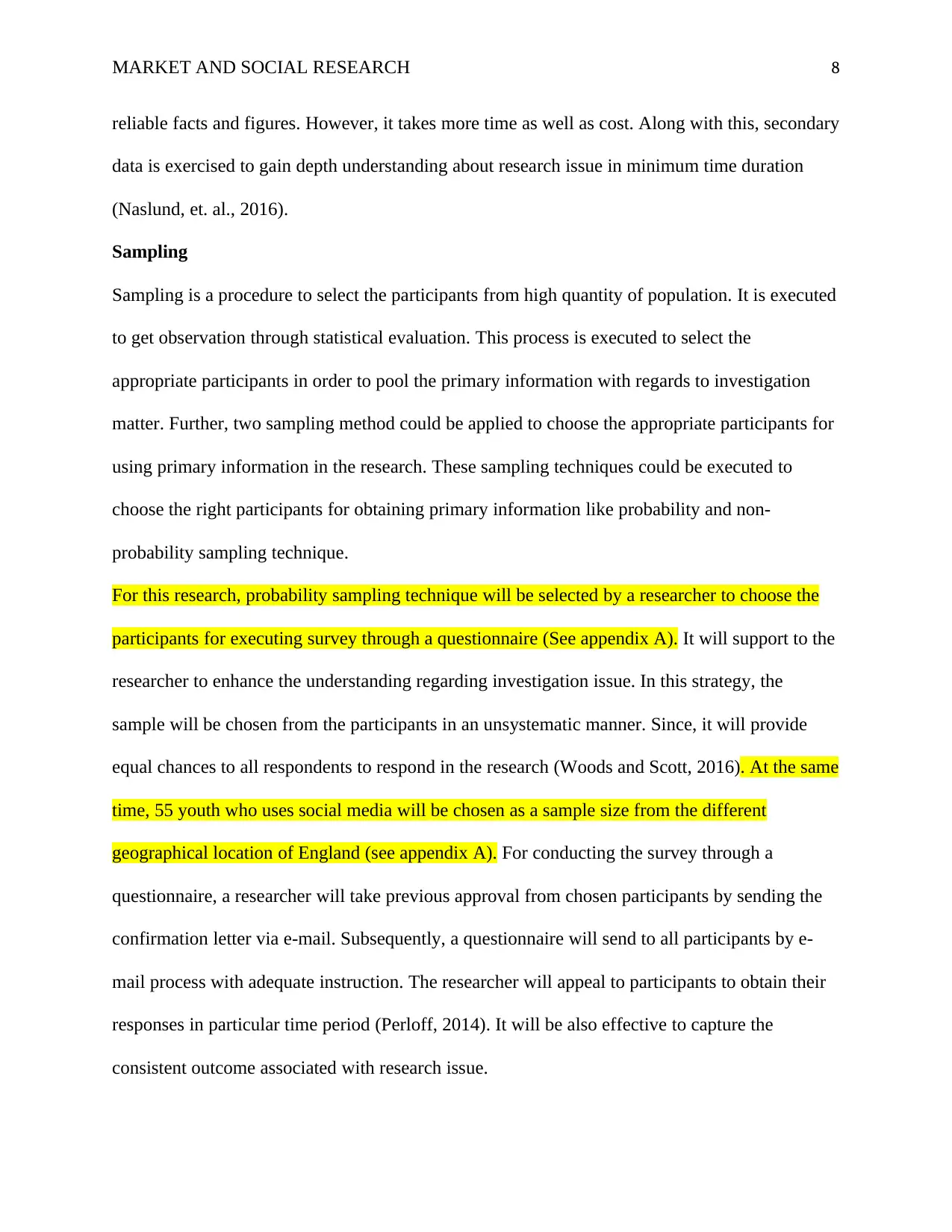
MARKET AND SOCIAL RESEARCH 8
reliable facts and figures. However, it takes more time as well as cost. Along with this, secondary
data is exercised to gain depth understanding about research issue in minimum time duration
(Naslund, et. al., 2016).
Sampling
Sampling is a procedure to select the participants from high quantity of population. It is executed
to get observation through statistical evaluation. This process is executed to select the
appropriate participants in order to pool the primary information with regards to investigation
matter. Further, two sampling method could be applied to choose the appropriate participants for
using primary information in the research. These sampling techniques could be executed to
choose the right participants for obtaining primary information like probability and non-
probability sampling technique.
For this research, probability sampling technique will be selected by a researcher to choose the
participants for executing survey through a questionnaire (See appendix A). It will support to the
researcher to enhance the understanding regarding investigation issue. In this strategy, the
sample will be chosen from the participants in an unsystematic manner. Since, it will provide
equal chances to all respondents to respond in the research (Woods and Scott, 2016). At the same
time, 55 youth who uses social media will be chosen as a sample size from the different
geographical location of England (see appendix A). For conducting the survey through a
questionnaire, a researcher will take previous approval from chosen participants by sending the
confirmation letter via e-mail. Subsequently, a questionnaire will send to all participants by e-
mail process with adequate instruction. The researcher will appeal to participants to obtain their
responses in particular time period (Perloff, 2014). It will be also effective to capture the
consistent outcome associated with research issue.
reliable facts and figures. However, it takes more time as well as cost. Along with this, secondary
data is exercised to gain depth understanding about research issue in minimum time duration
(Naslund, et. al., 2016).
Sampling
Sampling is a procedure to select the participants from high quantity of population. It is executed
to get observation through statistical evaluation. This process is executed to select the
appropriate participants in order to pool the primary information with regards to investigation
matter. Further, two sampling method could be applied to choose the appropriate participants for
using primary information in the research. These sampling techniques could be executed to
choose the right participants for obtaining primary information like probability and non-
probability sampling technique.
For this research, probability sampling technique will be selected by a researcher to choose the
participants for executing survey through a questionnaire (See appendix A). It will support to the
researcher to enhance the understanding regarding investigation issue. In this strategy, the
sample will be chosen from the participants in an unsystematic manner. Since, it will provide
equal chances to all respondents to respond in the research (Woods and Scott, 2016). At the same
time, 55 youth who uses social media will be chosen as a sample size from the different
geographical location of England (see appendix A). For conducting the survey through a
questionnaire, a researcher will take previous approval from chosen participants by sending the
confirmation letter via e-mail. Subsequently, a questionnaire will send to all participants by e-
mail process with adequate instruction. The researcher will appeal to participants to obtain their
responses in particular time period (Perloff, 2014). It will be also effective to capture the
consistent outcome associated with research issue.
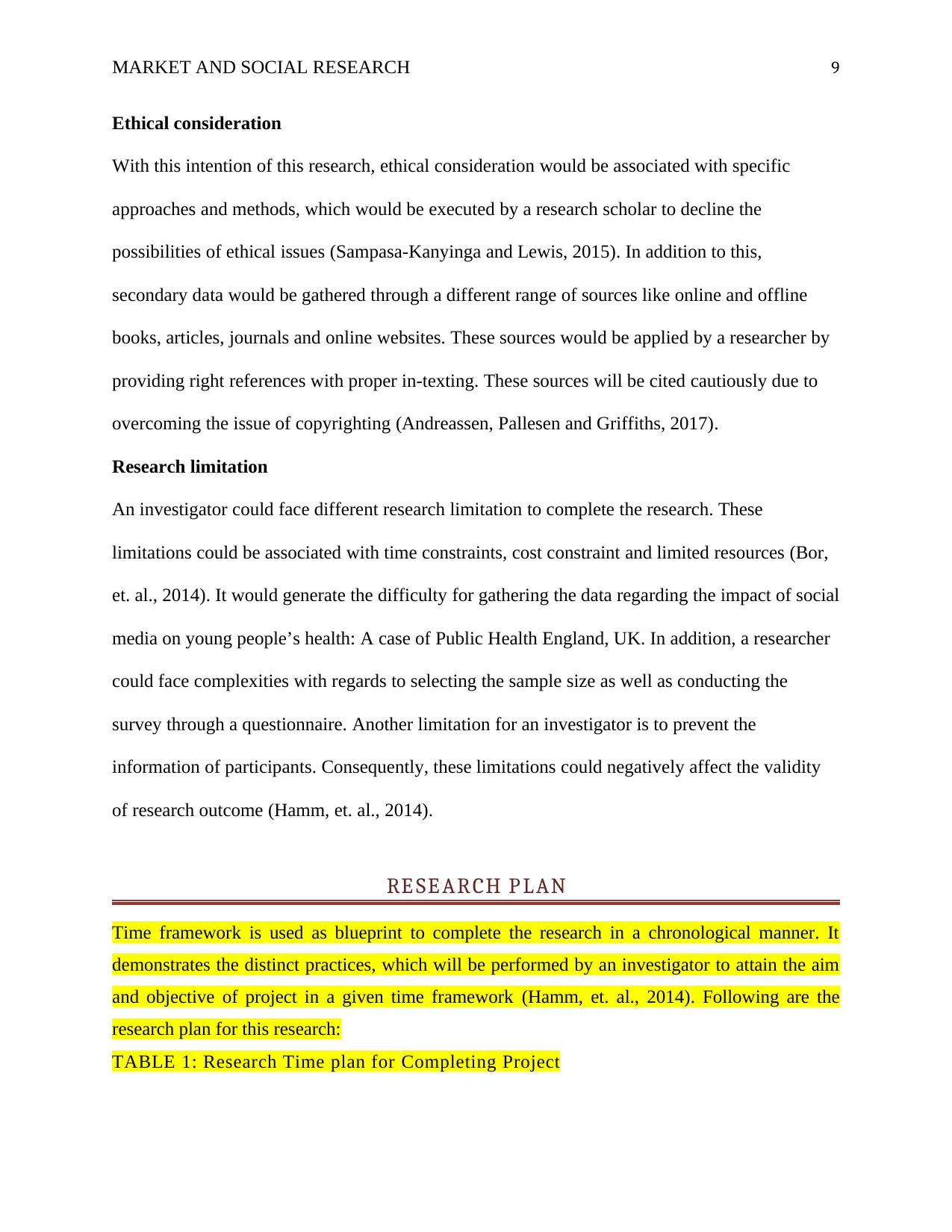
MARKET AND SOCIAL RESEARCH 9
Ethical consideration
With this intention of this research, ethical consideration would be associated with specific
approaches and methods, which would be executed by a research scholar to decline the
possibilities of ethical issues (Sampasa-Kanyinga and Lewis, 2015). In addition to this,
secondary data would be gathered through a different range of sources like online and offline
books, articles, journals and online websites. These sources would be applied by a researcher by
providing right references with proper in-texting. These sources will be cited cautiously due to
overcoming the issue of copyrighting (Andreassen, Pallesen and Griffiths, 2017).
Research limitation
An investigator could face different research limitation to complete the research. These
limitations could be associated with time constraints, cost constraint and limited resources (Bor,
et. al., 2014). It would generate the difficulty for gathering the data regarding the impact of social
media on young people’s health: A case of Public Health England, UK. In addition, a researcher
could face complexities with regards to selecting the sample size as well as conducting the
survey through a questionnaire. Another limitation for an investigator is to prevent the
information of participants. Consequently, these limitations could negatively affect the validity
of research outcome (Hamm, et. al., 2014).
RESEARCH PLAN
Time framework is used as blueprint to complete the research in a chronological manner. It
demonstrates the distinct practices, which will be performed by an investigator to attain the aim
and objective of project in a given time framework (Hamm, et. al., 2014). Following are the
research plan for this research:
TABLE 1: Research Time plan for Completing Project
Ethical consideration
With this intention of this research, ethical consideration would be associated with specific
approaches and methods, which would be executed by a research scholar to decline the
possibilities of ethical issues (Sampasa-Kanyinga and Lewis, 2015). In addition to this,
secondary data would be gathered through a different range of sources like online and offline
books, articles, journals and online websites. These sources would be applied by a researcher by
providing right references with proper in-texting. These sources will be cited cautiously due to
overcoming the issue of copyrighting (Andreassen, Pallesen and Griffiths, 2017).
Research limitation
An investigator could face different research limitation to complete the research. These
limitations could be associated with time constraints, cost constraint and limited resources (Bor,
et. al., 2014). It would generate the difficulty for gathering the data regarding the impact of social
media on young people’s health: A case of Public Health England, UK. In addition, a researcher
could face complexities with regards to selecting the sample size as well as conducting the
survey through a questionnaire. Another limitation for an investigator is to prevent the
information of participants. Consequently, these limitations could negatively affect the validity
of research outcome (Hamm, et. al., 2014).
RESEARCH PLAN
Time framework is used as blueprint to complete the research in a chronological manner. It
demonstrates the distinct practices, which will be performed by an investigator to attain the aim
and objective of project in a given time framework (Hamm, et. al., 2014). Following are the
research plan for this research:
TABLE 1: Research Time plan for Completing Project
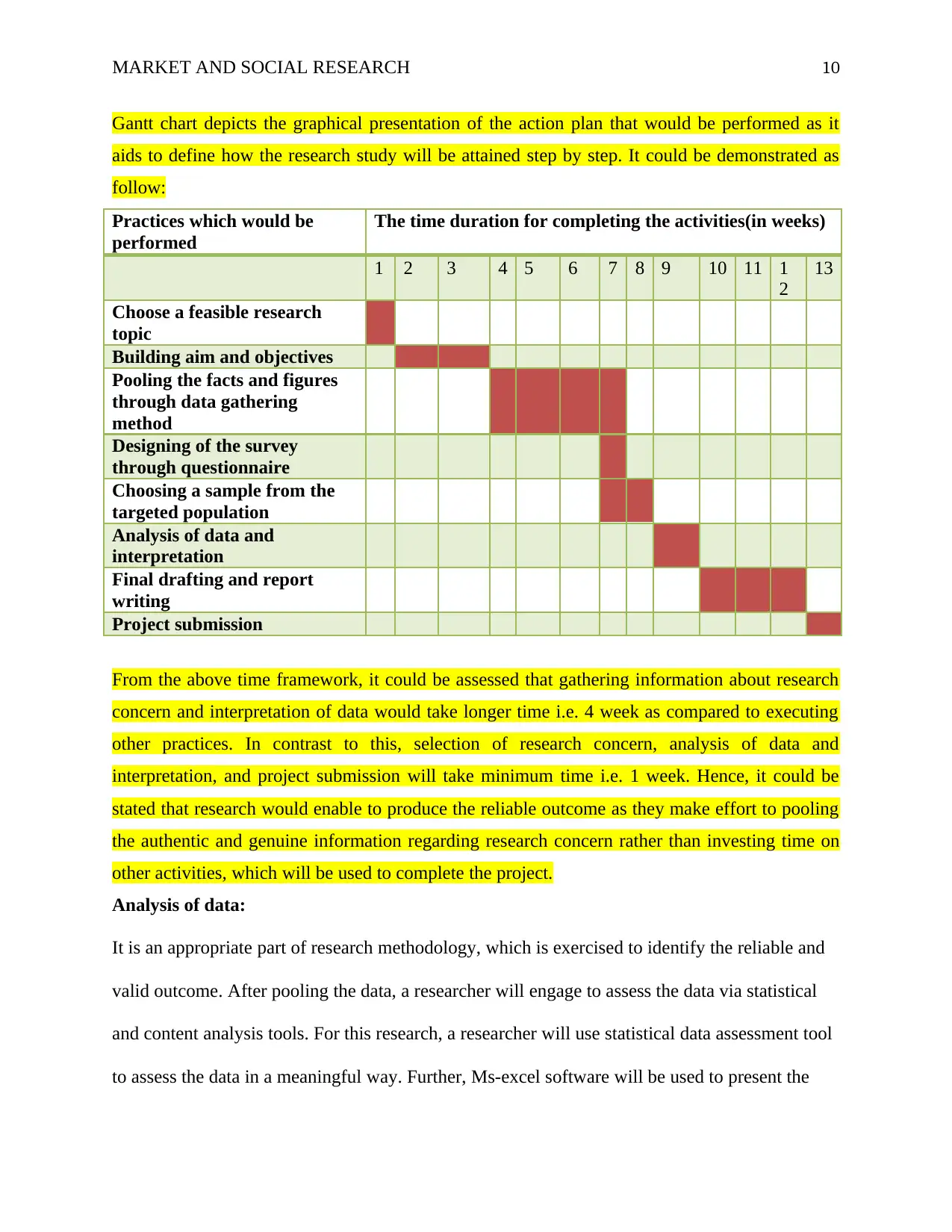
MARKET AND SOCIAL RESEARCH 10
Gantt chart depicts the graphical presentation of the action plan that would be performed as it
aids to define how the research study will be attained step by step. It could be demonstrated as
follow:
Practices which would be
performed
The time duration for completing the activities(in weeks)
1 2 3 4 5 6 7 8 9 10 11 1
2
13
Choose a feasible research
topic
Building aim and objectives
Pooling the facts and figures
through data gathering
method
Designing of the survey
through questionnaire
Choosing a sample from the
targeted population
Analysis of data and
interpretation
Final drafting and report
writing
Project submission
From the above time framework, it could be assessed that gathering information about research
concern and interpretation of data would take longer time i.e. 4 week as compared to executing
other practices. In contrast to this, selection of research concern, analysis of data and
interpretation, and project submission will take minimum time i.e. 1 week. Hence, it could be
stated that research would enable to produce the reliable outcome as they make effort to pooling
the authentic and genuine information regarding research concern rather than investing time on
other activities, which will be used to complete the project.
Analysis of data:
It is an appropriate part of research methodology, which is exercised to identify the reliable and
valid outcome. After pooling the data, a researcher will engage to assess the data via statistical
and content analysis tools. For this research, a researcher will use statistical data assessment tool
to assess the data in a meaningful way. Further, Ms-excel software will be used to present the
Gantt chart depicts the graphical presentation of the action plan that would be performed as it
aids to define how the research study will be attained step by step. It could be demonstrated as
follow:
Practices which would be
performed
The time duration for completing the activities(in weeks)
1 2 3 4 5 6 7 8 9 10 11 1
2
13
Choose a feasible research
topic
Building aim and objectives
Pooling the facts and figures
through data gathering
method
Designing of the survey
through questionnaire
Choosing a sample from the
targeted population
Analysis of data and
interpretation
Final drafting and report
writing
Project submission
From the above time framework, it could be assessed that gathering information about research
concern and interpretation of data would take longer time i.e. 4 week as compared to executing
other practices. In contrast to this, selection of research concern, analysis of data and
interpretation, and project submission will take minimum time i.e. 1 week. Hence, it could be
stated that research would enable to produce the reliable outcome as they make effort to pooling
the authentic and genuine information regarding research concern rather than investing time on
other activities, which will be used to complete the project.
Analysis of data:
It is an appropriate part of research methodology, which is exercised to identify the reliable and
valid outcome. After pooling the data, a researcher will engage to assess the data via statistical
and content analysis tools. For this research, a researcher will use statistical data assessment tool
to assess the data in a meaningful way. Further, Ms-excel software will be used to present the
Secure Best Marks with AI Grader
Need help grading? Try our AI Grader for instant feedback on your assignments.

MARKET AND SOCIAL RESEARCH 11
data through different charts, graphs, and tables. It would be effective to discuss the information
in a comprehensible way (Yamamoto, Kushin, and Dalisay, 2015).
data through different charts, graphs, and tables. It would be effective to discuss the information
in a comprehensible way (Yamamoto, Kushin, and Dalisay, 2015).

MARKET AND SOCIAL RESEARCH 12
DESIGN THE DATA COLLECTION INSTRUMENT:
APPENDIX 1: SURVEY THROUGH QUESTIONNAIRE
Please spell out your gender:
Female
Male
Please mention your age-group
24-28 years
28-32 years
32-36 years
Above 40 years
RO1: To analyze the attitude of youths towards social media and the amount of time they
spend on social media
Do you use any kind of social media?
Yes
No
How long have you been using social media sites?
Less than 6 months
6 months- 1 year
1 year – 4 year
More than 4 year
How many hours do you spend on social media daily?
1-3 hours
DESIGN THE DATA COLLECTION INSTRUMENT:
APPENDIX 1: SURVEY THROUGH QUESTIONNAIRE
Please spell out your gender:
Female
Male
Please mention your age-group
24-28 years
28-32 years
32-36 years
Above 40 years
RO1: To analyze the attitude of youths towards social media and the amount of time they
spend on social media
Do you use any kind of social media?
Yes
No
How long have you been using social media sites?
Less than 6 months
6 months- 1 year
1 year – 4 year
More than 4 year
How many hours do you spend on social media daily?
1-3 hours
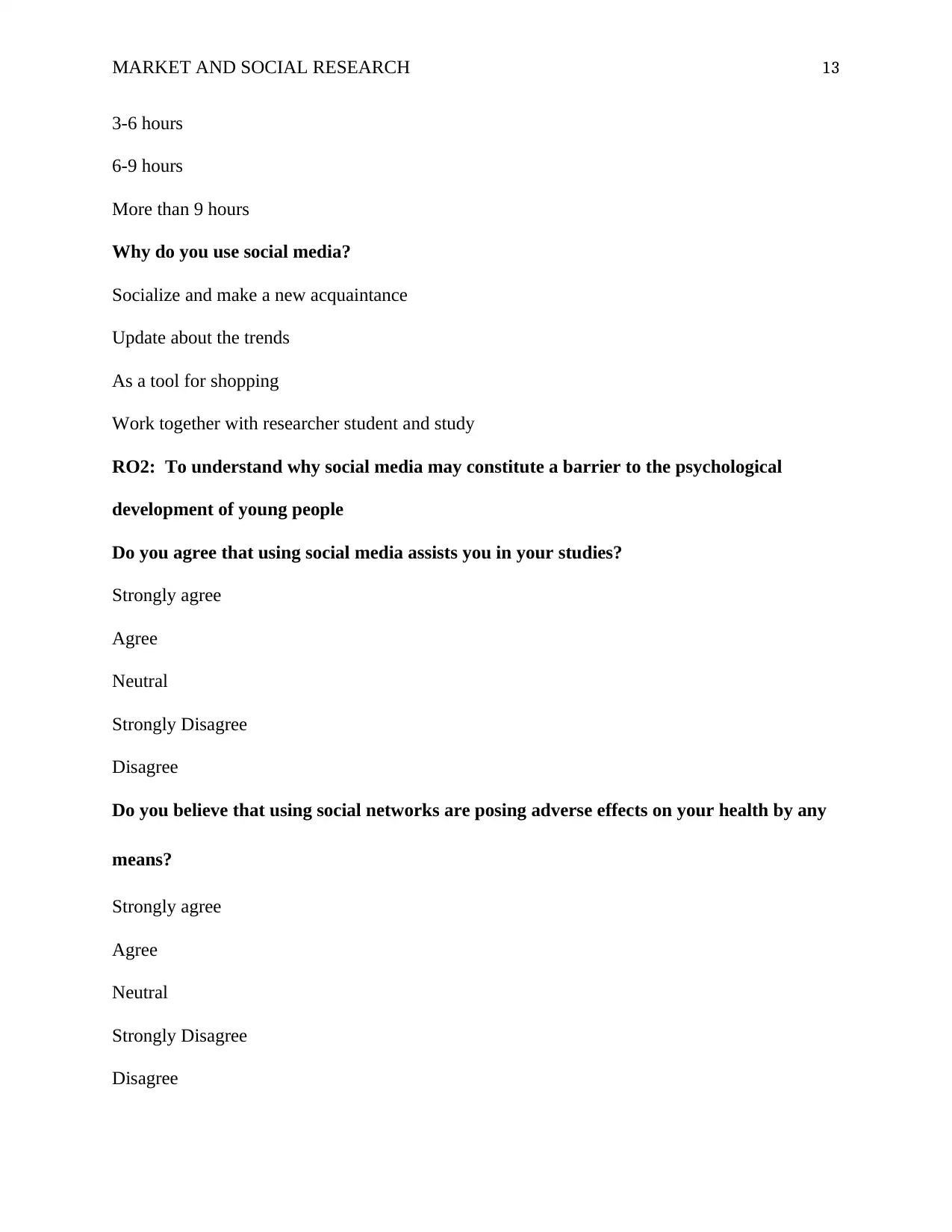
MARKET AND SOCIAL RESEARCH 13
3-6 hours
6-9 hours
More than 9 hours
Why do you use social media?
Socialize and make a new acquaintance
Update about the trends
As a tool for shopping
Work together with researcher student and study
RO2: To understand why social media may constitute a barrier to the psychological
development of young people
Do you agree that using social media assists you in your studies?
Strongly agree
Agree
Neutral
Strongly Disagree
Disagree
Do you believe that using social networks are posing adverse effects on your health by any
means?
Strongly agree
Agree
Neutral
Strongly Disagree
Disagree
3-6 hours
6-9 hours
More than 9 hours
Why do you use social media?
Socialize and make a new acquaintance
Update about the trends
As a tool for shopping
Work together with researcher student and study
RO2: To understand why social media may constitute a barrier to the psychological
development of young people
Do you agree that using social media assists you in your studies?
Strongly agree
Agree
Neutral
Strongly Disagree
Disagree
Do you believe that using social networks are posing adverse effects on your health by any
means?
Strongly agree
Agree
Neutral
Strongly Disagree
Disagree
Paraphrase This Document
Need a fresh take? Get an instant paraphrase of this document with our AI Paraphraser
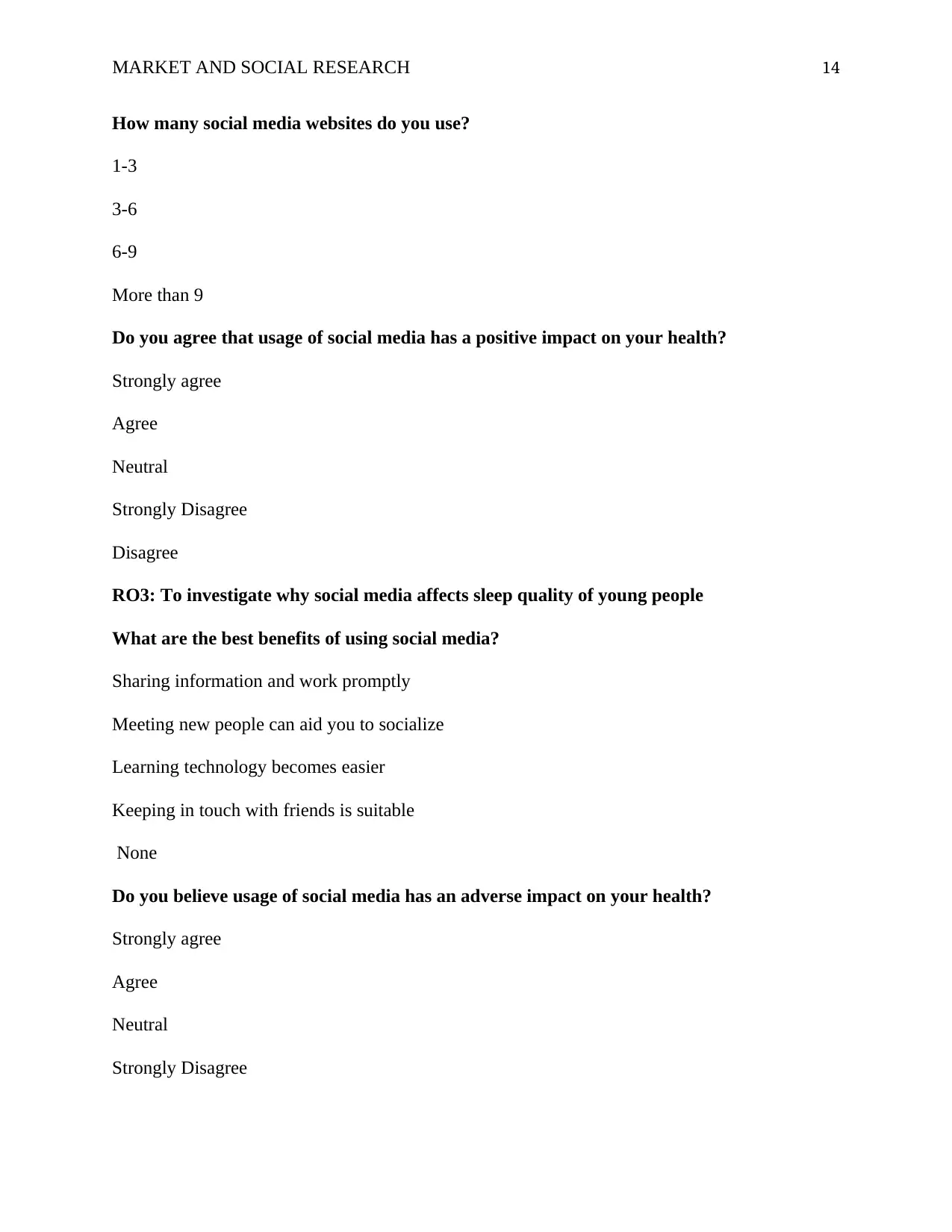
MARKET AND SOCIAL RESEARCH 14
How many social media websites do you use?
1-3
3-6
6-9
More than 9
Do you agree that usage of social media has a positive impact on your health?
Strongly agree
Agree
Neutral
Strongly Disagree
Disagree
RO3: To investigate why social media affects sleep quality of young people
What are the best benefits of using social media?
Sharing information and work promptly
Meeting new people can aid you to socialize
Learning technology becomes easier
Keeping in touch with friends is suitable
None
Do you believe usage of social media has an adverse impact on your health?
Strongly agree
Agree
Neutral
Strongly Disagree
How many social media websites do you use?
1-3
3-6
6-9
More than 9
Do you agree that usage of social media has a positive impact on your health?
Strongly agree
Agree
Neutral
Strongly Disagree
Disagree
RO3: To investigate why social media affects sleep quality of young people
What are the best benefits of using social media?
Sharing information and work promptly
Meeting new people can aid you to socialize
Learning technology becomes easier
Keeping in touch with friends is suitable
None
Do you believe usage of social media has an adverse impact on your health?
Strongly agree
Agree
Neutral
Strongly Disagree
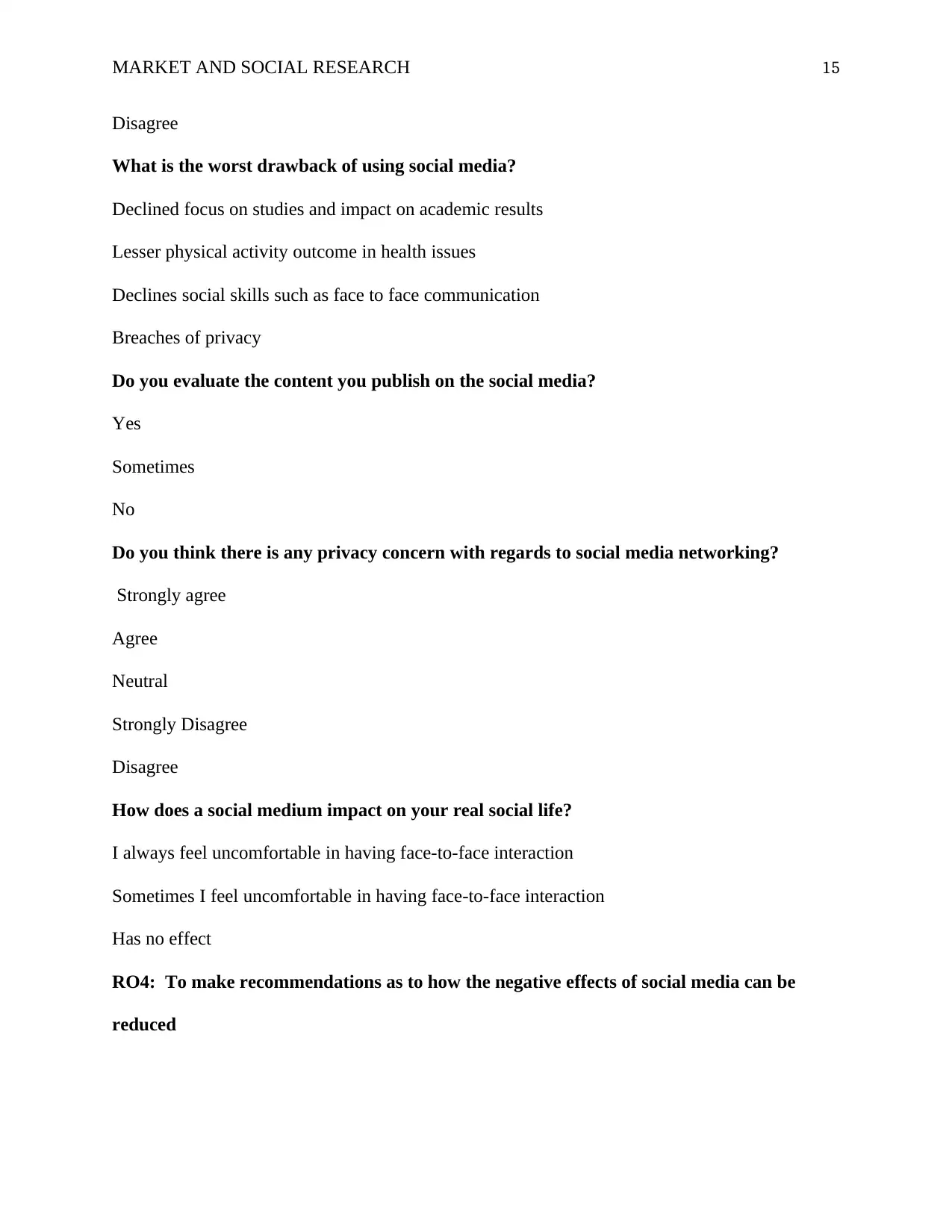
MARKET AND SOCIAL RESEARCH 15
Disagree
What is the worst drawback of using social media?
Declined focus on studies and impact on academic results
Lesser physical activity outcome in health issues
Declines social skills such as face to face communication
Breaches of privacy
Do you evaluate the content you publish on the social media?
Yes
Sometimes
No
Do you think there is any privacy concern with regards to social media networking?
Strongly agree
Agree
Neutral
Strongly Disagree
Disagree
How does a social medium impact on your real social life?
I always feel uncomfortable in having face-to-face interaction
Sometimes I feel uncomfortable in having face-to-face interaction
Has no effect
RO4: To make recommendations as to how the negative effects of social media can be
reduced
Disagree
What is the worst drawback of using social media?
Declined focus on studies and impact on academic results
Lesser physical activity outcome in health issues
Declines social skills such as face to face communication
Breaches of privacy
Do you evaluate the content you publish on the social media?
Yes
Sometimes
No
Do you think there is any privacy concern with regards to social media networking?
Strongly agree
Agree
Neutral
Strongly Disagree
Disagree
How does a social medium impact on your real social life?
I always feel uncomfortable in having face-to-face interaction
Sometimes I feel uncomfortable in having face-to-face interaction
Has no effect
RO4: To make recommendations as to how the negative effects of social media can be
reduced
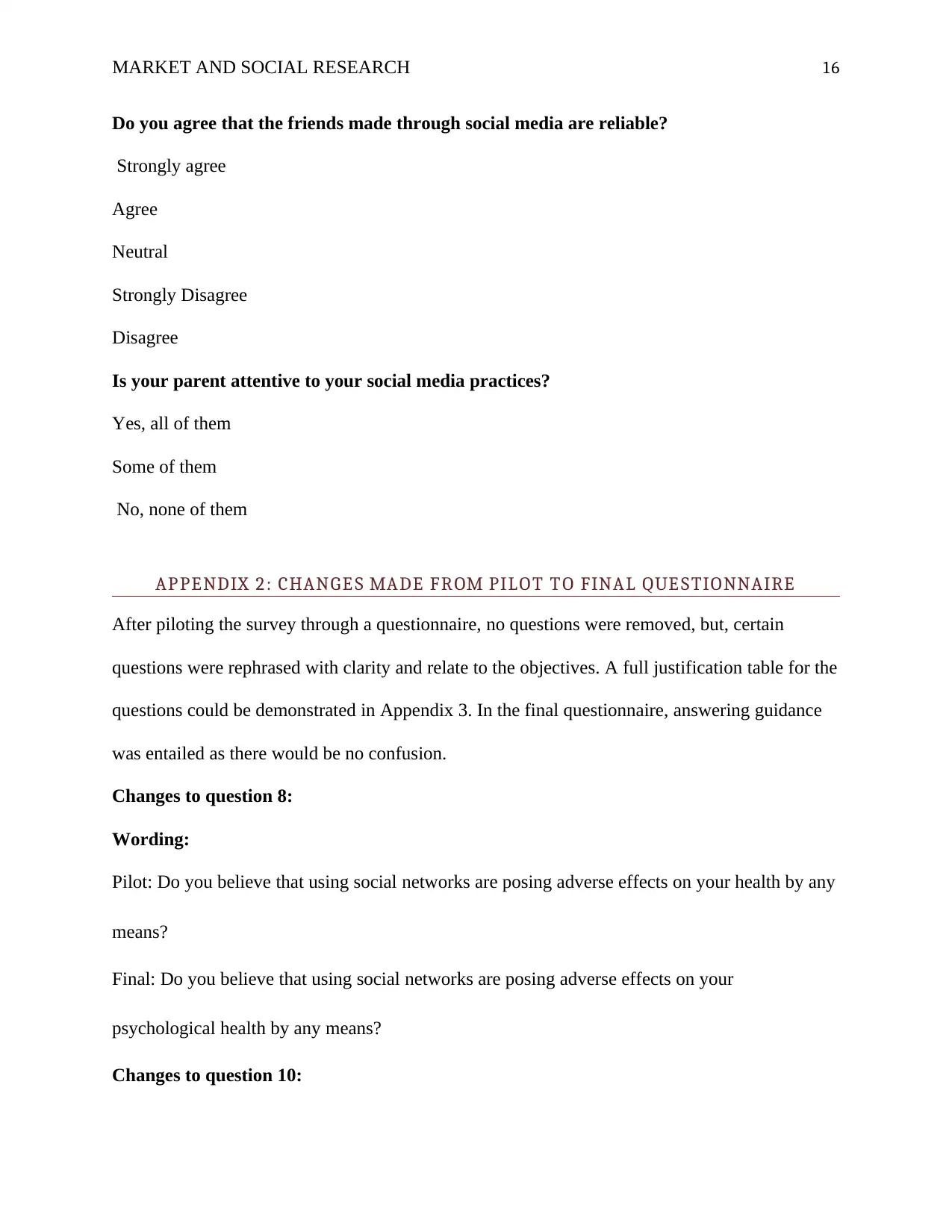
MARKET AND SOCIAL RESEARCH 16
Do you agree that the friends made through social media are reliable?
Strongly agree
Agree
Neutral
Strongly Disagree
Disagree
Is your parent attentive to your social media practices?
Yes, all of them
Some of them
No, none of them
APPENDIX 2: CHANGES MADE FROM PILOT TO FINAL QUESTIONNAIRE
After piloting the survey through a questionnaire, no questions were removed, but, certain
questions were rephrased with clarity and relate to the objectives. A full justification table for the
questions could be demonstrated in Appendix 3. In the final questionnaire, answering guidance
was entailed as there would be no confusion.
Changes to question 8:
Wording:
Pilot: Do you believe that using social networks are posing adverse effects on your health by any
means?
Final: Do you believe that using social networks are posing adverse effects on your
psychological health by any means?
Changes to question 10:
Do you agree that the friends made through social media are reliable?
Strongly agree
Agree
Neutral
Strongly Disagree
Disagree
Is your parent attentive to your social media practices?
Yes, all of them
Some of them
No, none of them
APPENDIX 2: CHANGES MADE FROM PILOT TO FINAL QUESTIONNAIRE
After piloting the survey through a questionnaire, no questions were removed, but, certain
questions were rephrased with clarity and relate to the objectives. A full justification table for the
questions could be demonstrated in Appendix 3. In the final questionnaire, answering guidance
was entailed as there would be no confusion.
Changes to question 8:
Wording:
Pilot: Do you believe that using social networks are posing adverse effects on your health by any
means?
Final: Do you believe that using social networks are posing adverse effects on your
psychological health by any means?
Changes to question 10:
Secure Best Marks with AI Grader
Need help grading? Try our AI Grader for instant feedback on your assignments.
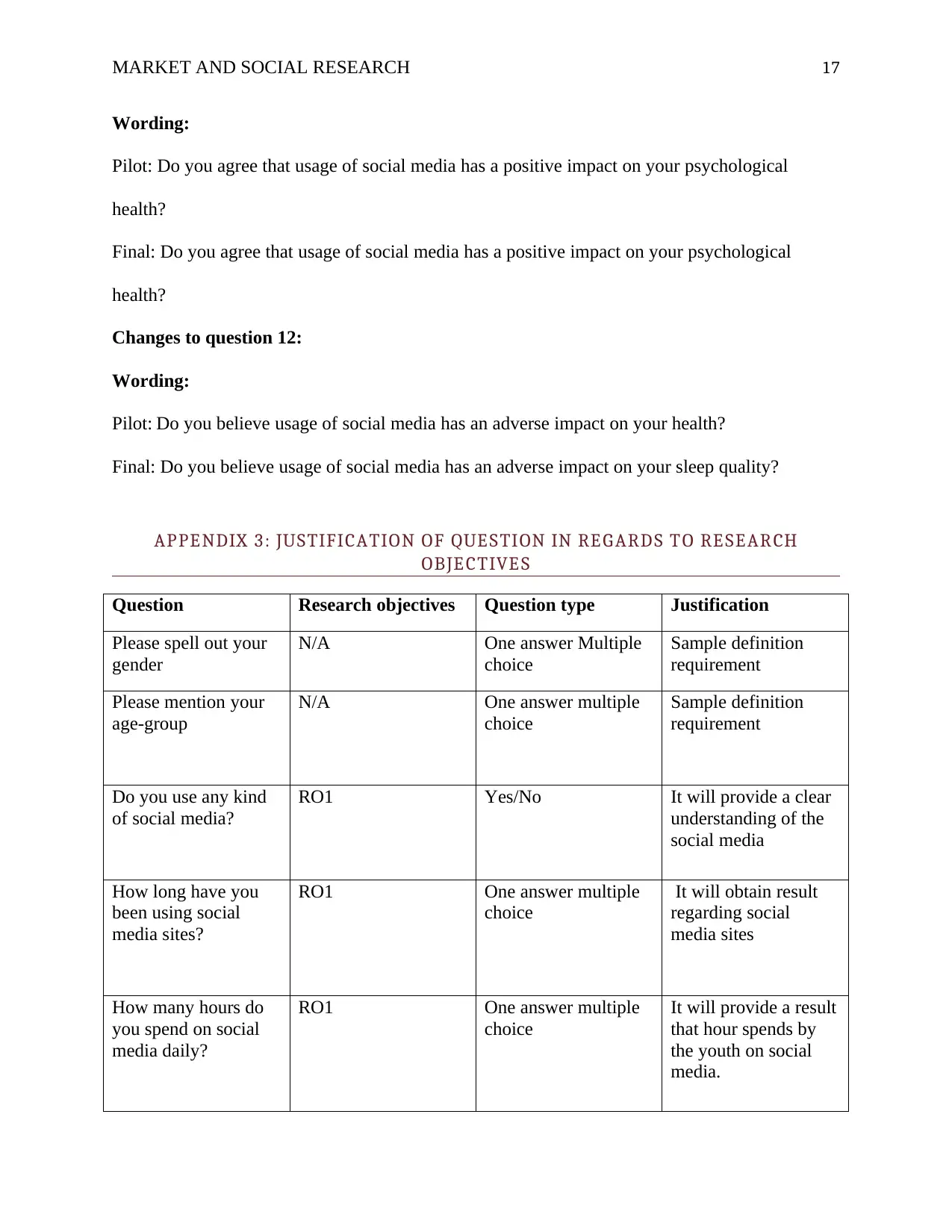
MARKET AND SOCIAL RESEARCH 17
Wording:
Pilot: Do you agree that usage of social media has a positive impact on your psychological
health?
Final: Do you agree that usage of social media has a positive impact on your psychological
health?
Changes to question 12:
Wording:
Pilot: Do you believe usage of social media has an adverse impact on your health?
Final: Do you believe usage of social media has an adverse impact on your sleep quality?
APPENDIX 3: JUSTIFICATION OF QUESTION IN REGARDS TO RESEARCH
OBJECTIVES
Question Research objectives Question type Justification
Please spell out your
gender
N/A One answer Multiple
choice
Sample definition
requirement
Please mention your
age-group
N/A One answer multiple
choice
Sample definition
requirement
Do you use any kind
of social media?
RO1 Yes/No It will provide a clear
understanding of the
social media
How long have you
been using social
media sites?
RO1 One answer multiple
choice
It will obtain result
regarding social
media sites
How many hours do
you spend on social
media daily?
RO1 One answer multiple
choice
It will provide a result
that hour spends by
the youth on social
media.
Wording:
Pilot: Do you agree that usage of social media has a positive impact on your psychological
health?
Final: Do you agree that usage of social media has a positive impact on your psychological
health?
Changes to question 12:
Wording:
Pilot: Do you believe usage of social media has an adverse impact on your health?
Final: Do you believe usage of social media has an adverse impact on your sleep quality?
APPENDIX 3: JUSTIFICATION OF QUESTION IN REGARDS TO RESEARCH
OBJECTIVES
Question Research objectives Question type Justification
Please spell out your
gender
N/A One answer Multiple
choice
Sample definition
requirement
Please mention your
age-group
N/A One answer multiple
choice
Sample definition
requirement
Do you use any kind
of social media?
RO1 Yes/No It will provide a clear
understanding of the
social media
How long have you
been using social
media sites?
RO1 One answer multiple
choice
It will obtain result
regarding social
media sites
How many hours do
you spend on social
media daily?
RO1 One answer multiple
choice
It will provide a result
that hour spends by
the youth on social
media.
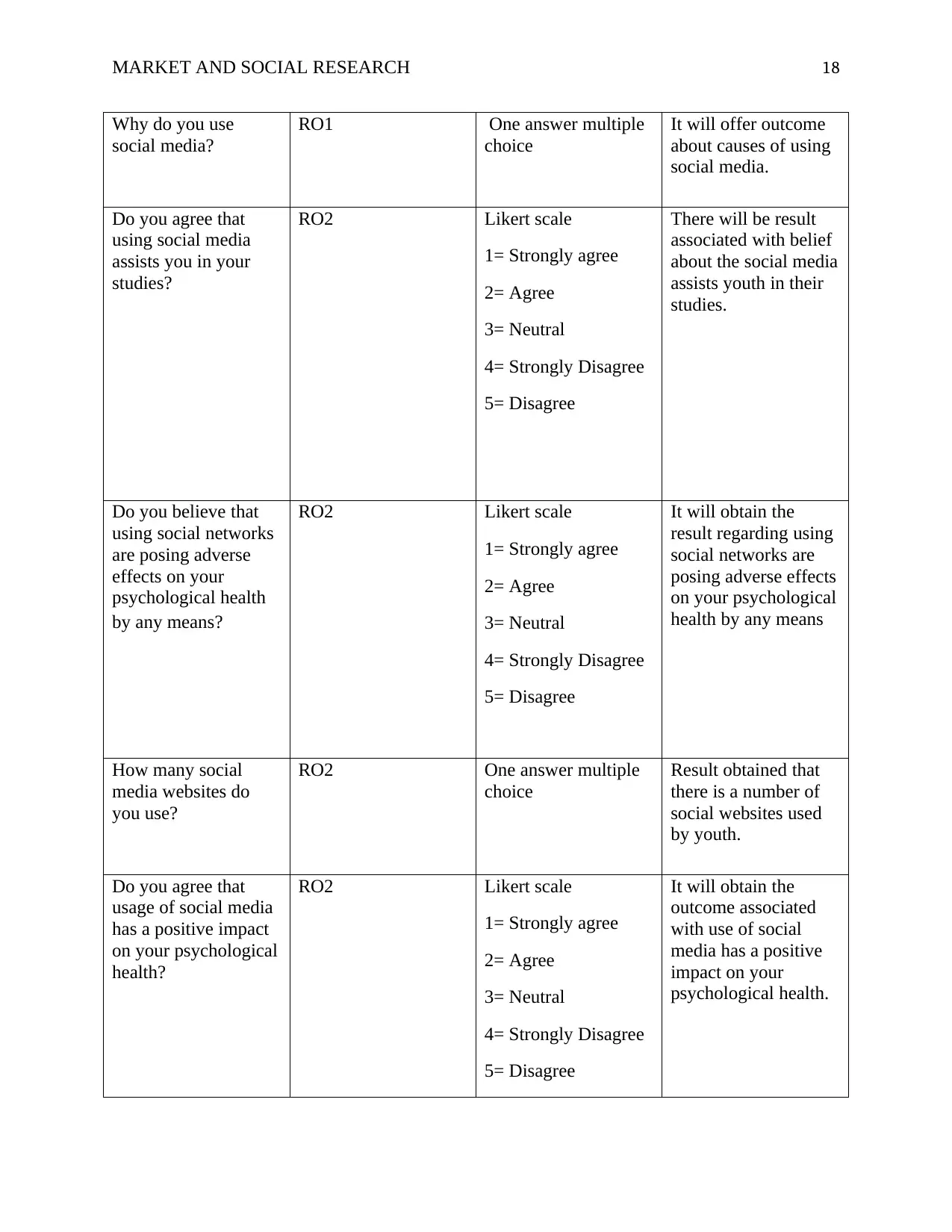
MARKET AND SOCIAL RESEARCH 18
Why do you use
social media?
RO1 One answer multiple
choice
It will offer outcome
about causes of using
social media.
Do you agree that
using social media
assists you in your
studies?
RO2 Likert scale
1= Strongly agree
2= Agree
3= Neutral
4= Strongly Disagree
5= Disagree
There will be result
associated with belief
about the social media
assists youth in their
studies.
Do you believe that
using social networks
are posing adverse
effects on your
psychological health
by any means?
RO2 Likert scale
1= Strongly agree
2= Agree
3= Neutral
4= Strongly Disagree
5= Disagree
It will obtain the
result regarding using
social networks are
posing adverse effects
on your psychological
health by any means
How many social
media websites do
you use?
RO2 One answer multiple
choice
Result obtained that
there is a number of
social websites used
by youth.
Do you agree that
usage of social media
has a positive impact
on your psychological
health?
RO2 Likert scale
1= Strongly agree
2= Agree
3= Neutral
4= Strongly Disagree
5= Disagree
It will obtain the
outcome associated
with use of social
media has a positive
impact on your
psychological health.
Why do you use
social media?
RO1 One answer multiple
choice
It will offer outcome
about causes of using
social media.
Do you agree that
using social media
assists you in your
studies?
RO2 Likert scale
1= Strongly agree
2= Agree
3= Neutral
4= Strongly Disagree
5= Disagree
There will be result
associated with belief
about the social media
assists youth in their
studies.
Do you believe that
using social networks
are posing adverse
effects on your
psychological health
by any means?
RO2 Likert scale
1= Strongly agree
2= Agree
3= Neutral
4= Strongly Disagree
5= Disagree
It will obtain the
result regarding using
social networks are
posing adverse effects
on your psychological
health by any means
How many social
media websites do
you use?
RO2 One answer multiple
choice
Result obtained that
there is a number of
social websites used
by youth.
Do you agree that
usage of social media
has a positive impact
on your psychological
health?
RO2 Likert scale
1= Strongly agree
2= Agree
3= Neutral
4= Strongly Disagree
5= Disagree
It will obtain the
outcome associated
with use of social
media has a positive
impact on your
psychological health.
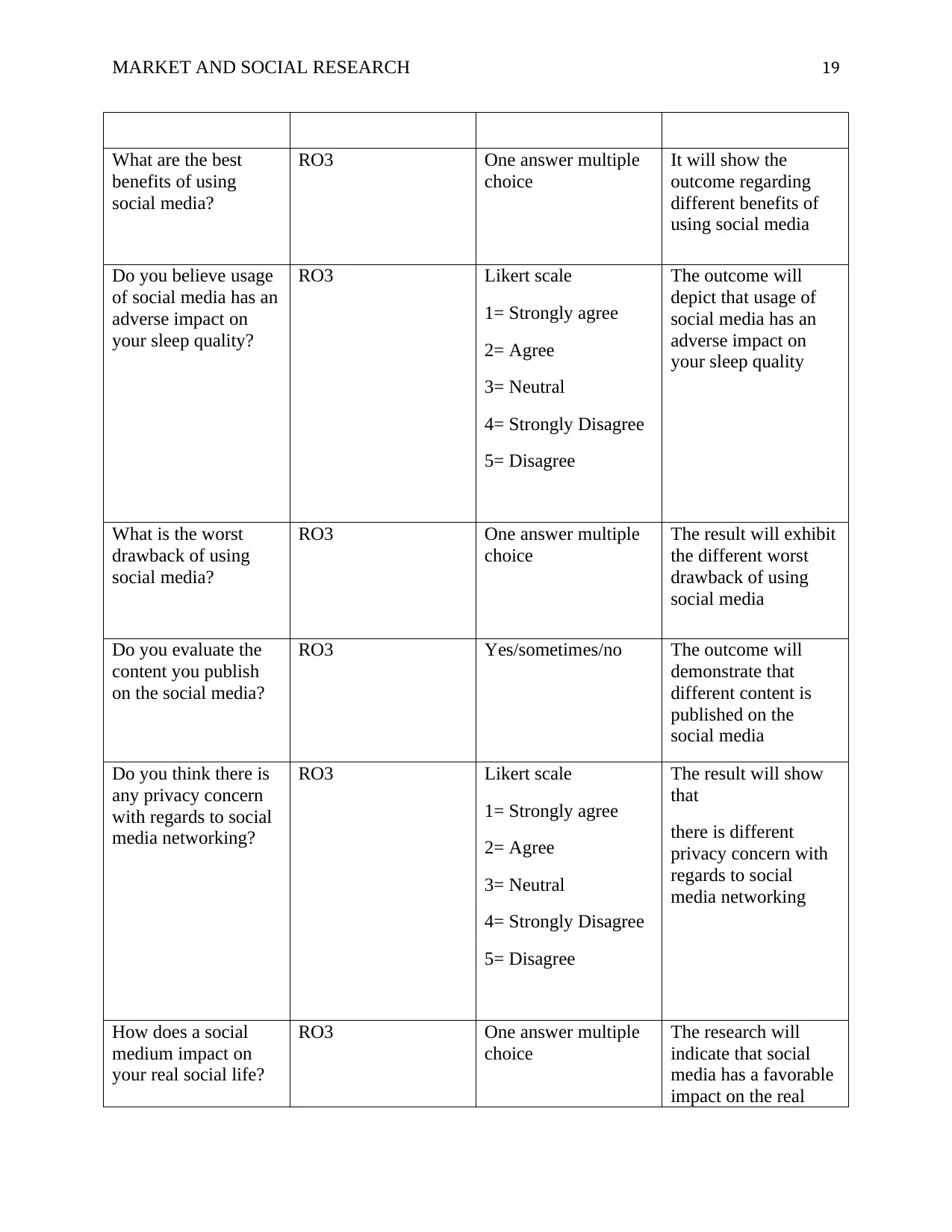
MARKET AND SOCIAL RESEARCH 19
What are the best
benefits of using
social media?
RO3 One answer multiple
choice
It will show the
outcome regarding
different benefits of
using social media
Do you believe usage
of social media has an
adverse impact on
your sleep quality?
RO3 Likert scale
1= Strongly agree
2= Agree
3= Neutral
4= Strongly Disagree
5= Disagree
The outcome will
depict that usage of
social media has an
adverse impact on
your sleep quality
What is the worst
drawback of using
social media?
RO3 One answer multiple
choice
The result will exhibit
the different worst
drawback of using
social media
Do you evaluate the
content you publish
on the social media?
RO3 Yes/sometimes/no The outcome will
demonstrate that
different content is
published on the
social media
Do you think there is
any privacy concern
with regards to social
media networking?
RO3 Likert scale
1= Strongly agree
2= Agree
3= Neutral
4= Strongly Disagree
5= Disagree
The result will show
that
there is different
privacy concern with
regards to social
media networking
How does a social
medium impact on
your real social life?
RO3 One answer multiple
choice
The research will
indicate that social
media has a favorable
impact on the real
What are the best
benefits of using
social media?
RO3 One answer multiple
choice
It will show the
outcome regarding
different benefits of
using social media
Do you believe usage
of social media has an
adverse impact on
your sleep quality?
RO3 Likert scale
1= Strongly agree
2= Agree
3= Neutral
4= Strongly Disagree
5= Disagree
The outcome will
depict that usage of
social media has an
adverse impact on
your sleep quality
What is the worst
drawback of using
social media?
RO3 One answer multiple
choice
The result will exhibit
the different worst
drawback of using
social media
Do you evaluate the
content you publish
on the social media?
RO3 Yes/sometimes/no The outcome will
demonstrate that
different content is
published on the
social media
Do you think there is
any privacy concern
with regards to social
media networking?
RO3 Likert scale
1= Strongly agree
2= Agree
3= Neutral
4= Strongly Disagree
5= Disagree
The result will show
that
there is different
privacy concern with
regards to social
media networking
How does a social
medium impact on
your real social life?
RO3 One answer multiple
choice
The research will
indicate that social
media has a favorable
impact on the real
Paraphrase This Document
Need a fresh take? Get an instant paraphrase of this document with our AI Paraphraser
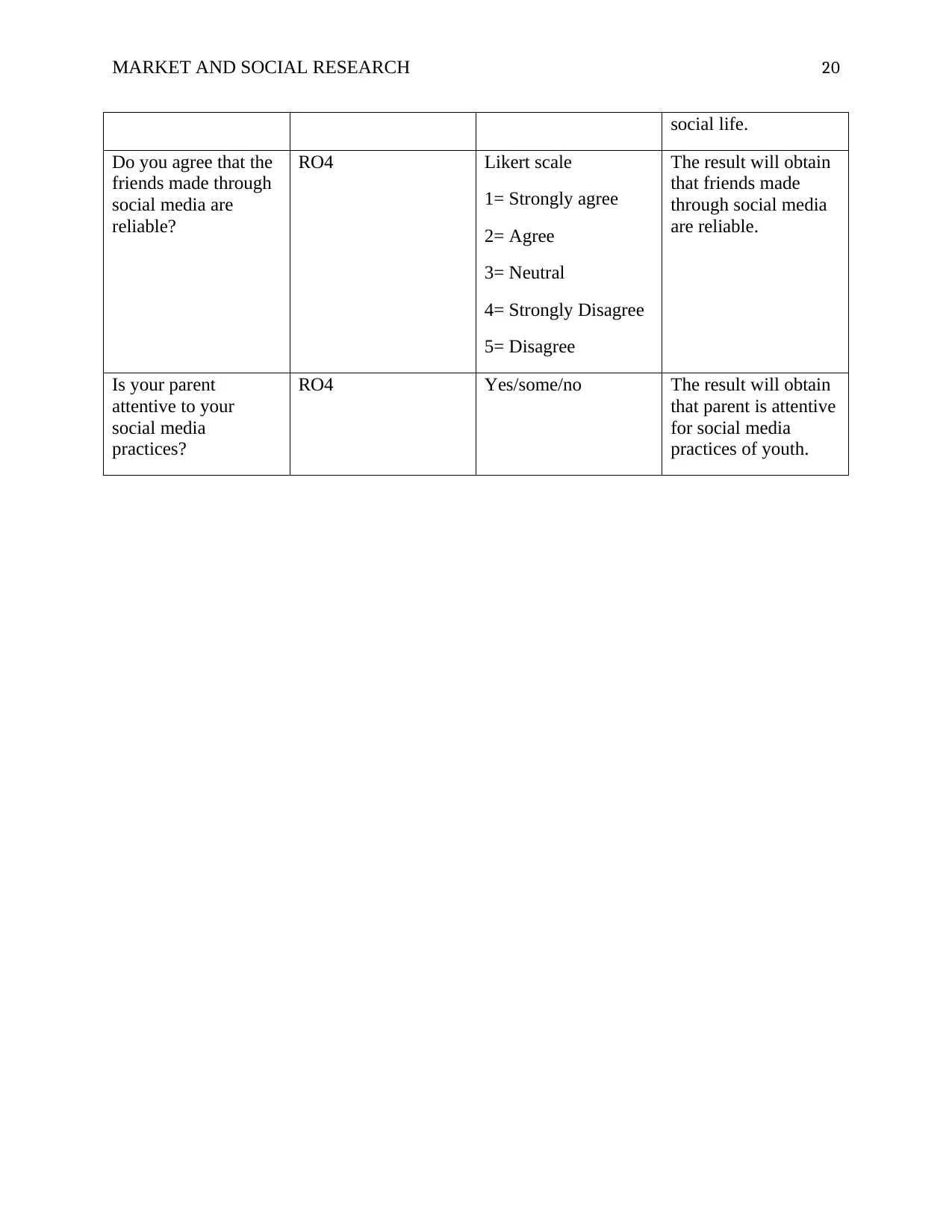
MARKET AND SOCIAL RESEARCH 20
social life.
Do you agree that the
friends made through
social media are
reliable?
RO4 Likert scale
1= Strongly agree
2= Agree
3= Neutral
4= Strongly Disagree
5= Disagree
The result will obtain
that friends made
through social media
are reliable.
Is your parent
attentive to your
social media
practices?
RO4 Yes/some/no The result will obtain
that parent is attentive
for social media
practices of youth.
social life.
Do you agree that the
friends made through
social media are
reliable?
RO4 Likert scale
1= Strongly agree
2= Agree
3= Neutral
4= Strongly Disagree
5= Disagree
The result will obtain
that friends made
through social media
are reliable.
Is your parent
attentive to your
social media
practices?
RO4 Yes/some/no The result will obtain
that parent is attentive
for social media
practices of youth.
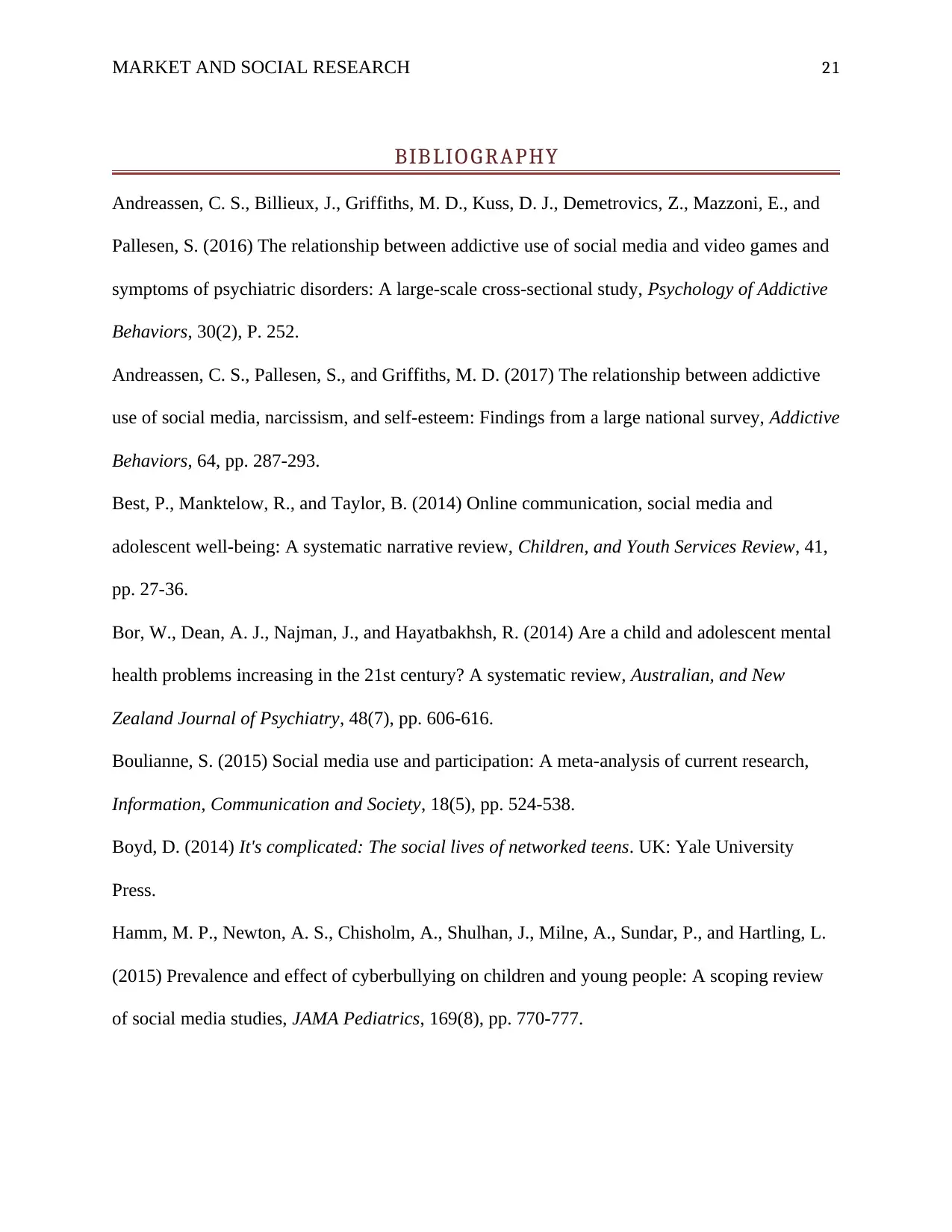
MARKET AND SOCIAL RESEARCH 21
BIBLIOGRAPHY
Andreassen, C. S., Billieux, J., Griffiths, M. D., Kuss, D. J., Demetrovics, Z., Mazzoni, E., and
Pallesen, S. (2016) The relationship between addictive use of social media and video games and
symptoms of psychiatric disorders: A large-scale cross-sectional study, Psychology of Addictive
Behaviors, 30(2), P. 252.
Andreassen, C. S., Pallesen, S., and Griffiths, M. D. (2017) The relationship between addictive
use of social media, narcissism, and self-esteem: Findings from a large national survey, Addictive
Behaviors, 64, pp. 287-293.
Best, P., Manktelow, R., and Taylor, B. (2014) Online communication, social media and
adolescent well-being: A systematic narrative review, Children, and Youth Services Review, 41,
pp. 27-36.
Bor, W., Dean, A. J., Najman, J., and Hayatbakhsh, R. (2014) Are a child and adolescent mental
health problems increasing in the 21st century? A systematic review, Australian, and New
Zealand Journal of Psychiatry, 48(7), pp. 606-616.
Boulianne, S. (2015) Social media use and participation: A meta-analysis of current research,
Information, Communication and Society, 18(5), pp. 524-538.
Boyd, D. (2014) It's complicated: The social lives of networked teens. UK: Yale University
Press.
Hamm, M. P., Newton, A. S., Chisholm, A., Shulhan, J., Milne, A., Sundar, P., and Hartling, L.
(2015) Prevalence and effect of cyberbullying on children and young people: A scoping review
of social media studies, JAMA Pediatrics, 169(8), pp. 770-777.
BIBLIOGRAPHY
Andreassen, C. S., Billieux, J., Griffiths, M. D., Kuss, D. J., Demetrovics, Z., Mazzoni, E., and
Pallesen, S. (2016) The relationship between addictive use of social media and video games and
symptoms of psychiatric disorders: A large-scale cross-sectional study, Psychology of Addictive
Behaviors, 30(2), P. 252.
Andreassen, C. S., Pallesen, S., and Griffiths, M. D. (2017) The relationship between addictive
use of social media, narcissism, and self-esteem: Findings from a large national survey, Addictive
Behaviors, 64, pp. 287-293.
Best, P., Manktelow, R., and Taylor, B. (2014) Online communication, social media and
adolescent well-being: A systematic narrative review, Children, and Youth Services Review, 41,
pp. 27-36.
Bor, W., Dean, A. J., Najman, J., and Hayatbakhsh, R. (2014) Are a child and adolescent mental
health problems increasing in the 21st century? A systematic review, Australian, and New
Zealand Journal of Psychiatry, 48(7), pp. 606-616.
Boulianne, S. (2015) Social media use and participation: A meta-analysis of current research,
Information, Communication and Society, 18(5), pp. 524-538.
Boyd, D. (2014) It's complicated: The social lives of networked teens. UK: Yale University
Press.
Hamm, M. P., Newton, A. S., Chisholm, A., Shulhan, J., Milne, A., Sundar, P., and Hartling, L.
(2015) Prevalence and effect of cyberbullying on children and young people: A scoping review
of social media studies, JAMA Pediatrics, 169(8), pp. 770-777.
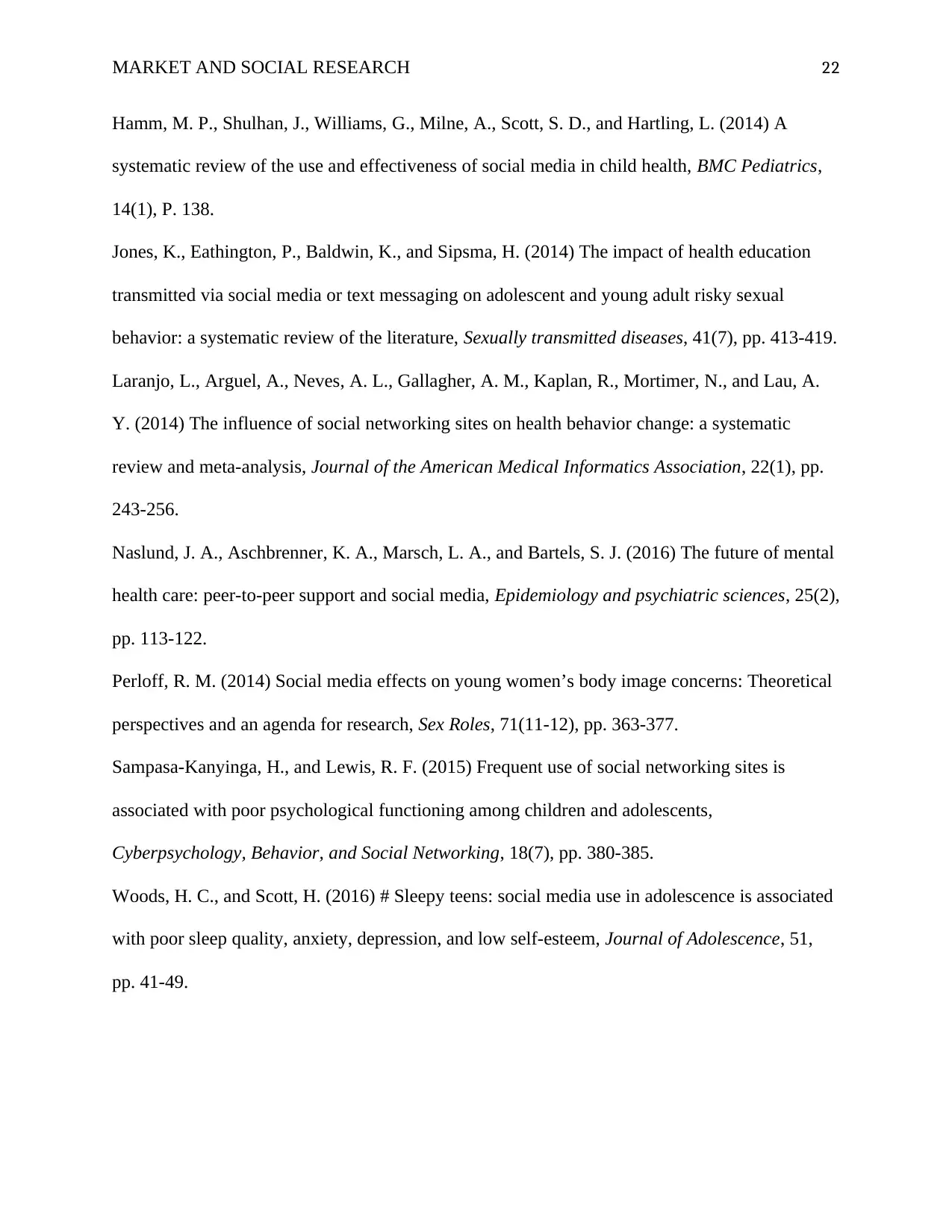
MARKET AND SOCIAL RESEARCH 22
Hamm, M. P., Shulhan, J., Williams, G., Milne, A., Scott, S. D., and Hartling, L. (2014) A
systematic review of the use and effectiveness of social media in child health, BMC Pediatrics,
14(1), P. 138.
Jones, K., Eathington, P., Baldwin, K., and Sipsma, H. (2014) The impact of health education
transmitted via social media or text messaging on adolescent and young adult risky sexual
behavior: a systematic review of the literature, Sexually transmitted diseases, 41(7), pp. 413-419.
Laranjo, L., Arguel, A., Neves, A. L., Gallagher, A. M., Kaplan, R., Mortimer, N., and Lau, A.
Y. (2014) The influence of social networking sites on health behavior change: a systematic
review and meta-analysis, Journal of the American Medical Informatics Association, 22(1), pp.
243-256.
Naslund, J. A., Aschbrenner, K. A., Marsch, L. A., and Bartels, S. J. (2016) The future of mental
health care: peer-to-peer support and social media, Epidemiology and psychiatric sciences, 25(2),
pp. 113-122.
Perloff, R. M. (2014) Social media effects on young women’s body image concerns: Theoretical
perspectives and an agenda for research, Sex Roles, 71(11-12), pp. 363-377.
Sampasa-Kanyinga, H., and Lewis, R. F. (2015) Frequent use of social networking sites is
associated with poor psychological functioning among children and adolescents,
Cyberpsychology, Behavior, and Social Networking, 18(7), pp. 380-385.
Woods, H. C., and Scott, H. (2016) # Sleepy teens: social media use in adolescence is associated
with poor sleep quality, anxiety, depression, and low self-esteem, Journal of Adolescence, 51,
pp. 41-49.
Hamm, M. P., Shulhan, J., Williams, G., Milne, A., Scott, S. D., and Hartling, L. (2014) A
systematic review of the use and effectiveness of social media in child health, BMC Pediatrics,
14(1), P. 138.
Jones, K., Eathington, P., Baldwin, K., and Sipsma, H. (2014) The impact of health education
transmitted via social media or text messaging on adolescent and young adult risky sexual
behavior: a systematic review of the literature, Sexually transmitted diseases, 41(7), pp. 413-419.
Laranjo, L., Arguel, A., Neves, A. L., Gallagher, A. M., Kaplan, R., Mortimer, N., and Lau, A.
Y. (2014) The influence of social networking sites on health behavior change: a systematic
review and meta-analysis, Journal of the American Medical Informatics Association, 22(1), pp.
243-256.
Naslund, J. A., Aschbrenner, K. A., Marsch, L. A., and Bartels, S. J. (2016) The future of mental
health care: peer-to-peer support and social media, Epidemiology and psychiatric sciences, 25(2),
pp. 113-122.
Perloff, R. M. (2014) Social media effects on young women’s body image concerns: Theoretical
perspectives and an agenda for research, Sex Roles, 71(11-12), pp. 363-377.
Sampasa-Kanyinga, H., and Lewis, R. F. (2015) Frequent use of social networking sites is
associated with poor psychological functioning among children and adolescents,
Cyberpsychology, Behavior, and Social Networking, 18(7), pp. 380-385.
Woods, H. C., and Scott, H. (2016) # Sleepy teens: social media use in adolescence is associated
with poor sleep quality, anxiety, depression, and low self-esteem, Journal of Adolescence, 51,
pp. 41-49.
Secure Best Marks with AI Grader
Need help grading? Try our AI Grader for instant feedback on your assignments.
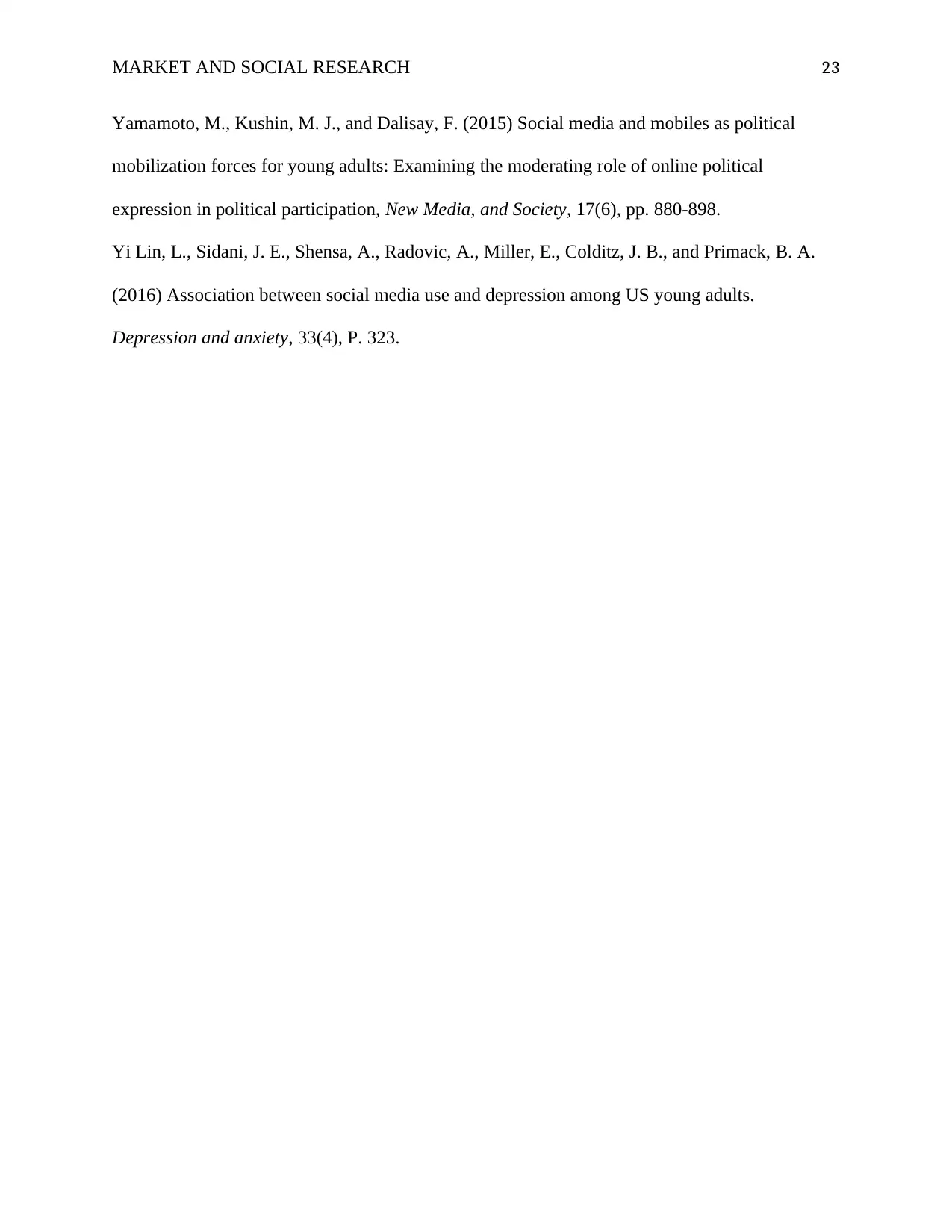
MARKET AND SOCIAL RESEARCH 23
Yamamoto, M., Kushin, M. J., and Dalisay, F. (2015) Social media and mobiles as political
mobilization forces for young adults: Examining the moderating role of online political
expression in political participation, New Media, and Society, 17(6), pp. 880-898.
Yi Lin, L., Sidani, J. E., Shensa, A., Radovic, A., Miller, E., Colditz, J. B., and Primack, B. A.
(2016) Association between social media use and depression among US young adults.
Depression and anxiety, 33(4), P. 323.
Yamamoto, M., Kushin, M. J., and Dalisay, F. (2015) Social media and mobiles as political
mobilization forces for young adults: Examining the moderating role of online political
expression in political participation, New Media, and Society, 17(6), pp. 880-898.
Yi Lin, L., Sidani, J. E., Shensa, A., Radovic, A., Miller, E., Colditz, J. B., and Primack, B. A.
(2016) Association between social media use and depression among US young adults.
Depression and anxiety, 33(4), P. 323.
1 out of 23
Related Documents
Your All-in-One AI-Powered Toolkit for Academic Success.
+13062052269
info@desklib.com
Available 24*7 on WhatsApp / Email
![[object Object]](/_next/static/media/star-bottom.7253800d.svg)
Unlock your academic potential
© 2024 | Zucol Services PVT LTD | All rights reserved.




